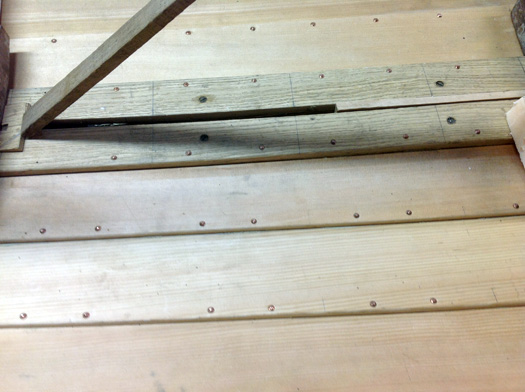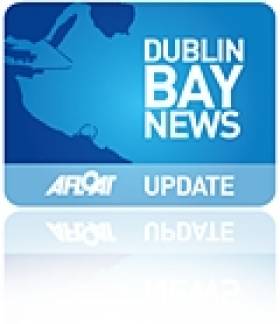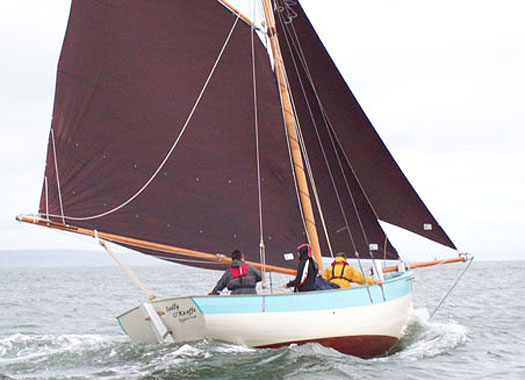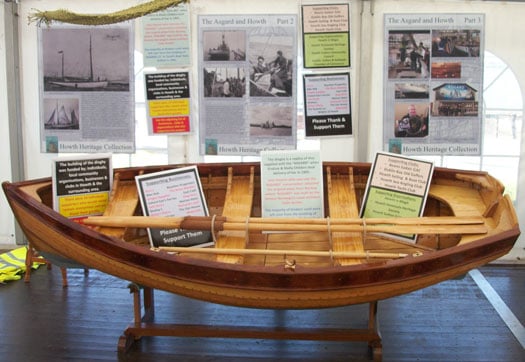Displaying items by tag: WM Nixon
#roundireland – Since 1980, the biennial 704-mile Round Ireland Race has been a cornerstone of Ireland's sailing programme. This year's fleet of 36 boats is good for the times that are in it, though it's still a far cry from the heady day of the 1990s when 54 boats came to the line. W M Nixon takes a look at the varied fleet for this 18th Edition of Ireland's Classic.
You wouldn't borrow money to go drinking with Enda O'Coineen on a Saturday night. But if you had to go into the jungle, or face up to a storm at sea, then he's a good man to have around. The intrepid Galwegian has been Irish sailing's gadfly for quite some time now. And more than occasionally, he has driven everyone else nuts - sometimes to the point of total exasperation - with his many cage-rattling schemes.
So his teaming-up for today's start on the Open 60 Teng Tools Kilcullen with Round Ireland Race super-veteran Eamon Crosbie is all of a piece for someone who crossed the Atlantic (at the second attempt) alone in a rubber dinghy, and was himself involved in two successful round Ireland record challenges.
It was the second of these records, in November (yes, November) 1986, which showed just what a cool and tough customer The Enda can be. The lumbering 83ft catamaran Novanet was making good progress on a clockwise circuit in a westerly wind north of Achill when the weather closed in with dark winter violence, a sudden cold front from north of northwest bringing ferocious hail squalls. Where they'd been comfortably clearing the sinister Black Rock off the coast of Mayo, now it was touch and go. Yet in the turbulent sea it was highly unlikely that the cumbersome big machine would be able to tack. The situation was dire, and one of the crew – a known millionaire – offered to buy the boat outright there and then if they'd run her up on a nearby beach.
The rest of them had to shout the options above the screams of the weather. But Enda wasn't saying a word. He just concentrated on taking running fixes of the painfully slowly changing bearing as the Black Rock light showed briefly through the squalls. "We're clearing it," he said quietly. "But by how much?" roared the would-be boat purchaser. "We're clearing it, just keep her going" was all that Enda would reveal.
To this day, nobody knows by precisely how much they did clear the rock on that November evening. It wasn't a lot, and might only have been a few feet. But clear it they did, and within 24 hours Novanet had completed her circuit and the new record stood until September 1993, when Steve Fossett with the 60ft trimaran Lakota established the astonishing record which still stands today.

The lumbering giant.....Enda O Coineen's cool pilotage of the 83ft catamaran Novanet on a stormy November night in 1986 saw her safely past the Black Rock in Mayo, and a new Round Ireland Record next day.
It's unlikely that there'll be any record breaking by the fleet going off this afternoon. For record-breaking purposes, it's best to see Ireland as a sort of green lozenge on a northeast/southwest axis, which means that any serious record-breaking attempt will hope to have a steady period of either nor'westers or sou'easters to give it a head start.
So the forecast of a nor'easter today may indeed send the fleet away in style. But the prospect of a long light airs beat up the west coast as the incoming high pressure builds will make the race a test of patience, and it will be a matter of getting to the finish eventually (and still talking to each other), rather than shaping up for a record.
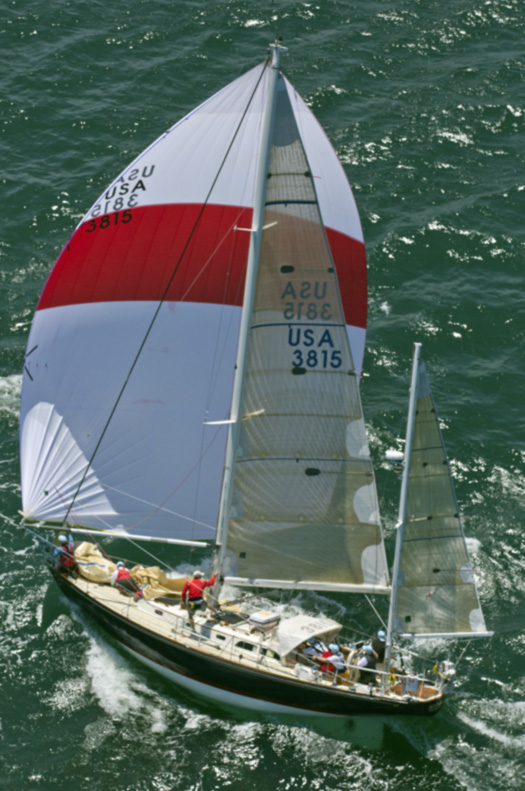
The Hinckley 40 Actaea (Michael Core), a comfortable cruiser-racer which yesterday was declared overall corrected time winner of the biennial 635-mile Bermuda Race. Photo: Daniel Forster
There doesn't seem to be a lot of wind about anywhere in the North Atlantic just now, as America's biennial 635-mile Newport-Bermuda Race has been very slow-sailed this past week since starting on Friday June 20th. For long stages, the best progress was being made by boat which got themselves into the most favourable eddies of the Gulf Stream, which in one location were the equivalent of a fair tide of 2 knots plus. Such conditions favour the lowest-rated most comfortable cruising style boats. So although the mini-maxi Shockwave took line honours, the corrected times were something of a shockwave in themselves, as the overall winner was Michael Core's well-sailed classic Hinckley Bermuda 40 yawl Actaea .
The Round Ireland fleet includes two boats of the same fairly hefty type as Actaea, and even without the news from Bermuda (where the Dark 'n Stormies are being consumed apace), both Ian Hickey's Granada 38 Cavatina from Cork and Brian O'Sullivan & Frances Clifford's Oyster 37 Amazing Grace from Tralee, were already highly favoured in the betting. Cavatina has been in the frame – including overall win – in several Round Irelands, while Amazing Grace celebrated her inauguration in the O'Sullivan/Clifford ownership last year by winning the Dun Laoghaire-Dingle overall after the wind taps had been turned off.
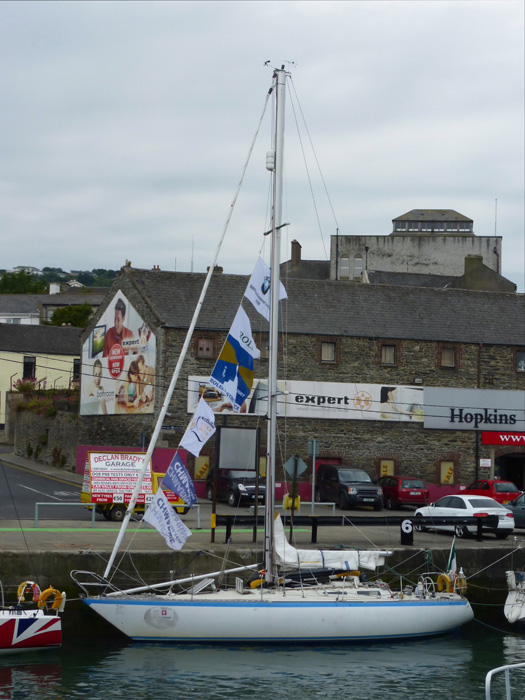
Cavatina in Wicklow on Thursday, with battle flags which reflect her distinguished career. Photo: W M Nixon
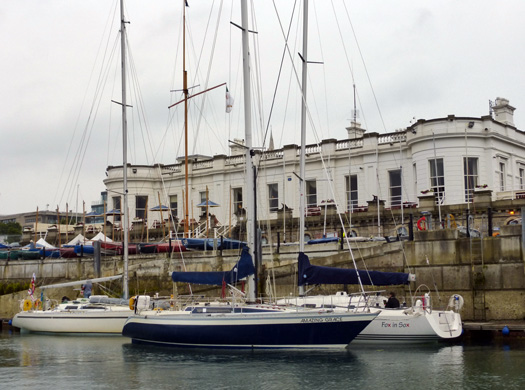
Amazing Grace at the Dun Laoghaire base of the Round Ireland Race at the Royal Irish YC on Thursday. Last year, light winds in the middle stage of the Dun Laoghaire-Dingle Race set up a pattern which provided overall victory for this Tralee Bay boat. Photo: W M Nixon
With Cavatina rated at only 0.922 and Amazing Grace just a little higher at 0.928, they're piling up the advantage just sitting still. But two boats rate even lower. These are the Dehler 34 Big Deal from Foynes, raced by the Listowel father-and-son team of Derek & Conor Dillon in the two-handed division, and the Isle of Man Sigma 33 Manx Polish (Kuba Szymanski) which clocks in at just 0.898, and has impressed with her showing in ISORA racing in recent years.
The smallest boat of all is not the lowest rated. The tiddler of the fleet - just scraping in over the 30ft LOA lower limit - is Ian Patterson's North Channel 9m Wildwood from East Antrim Boat Club in Larne. Having a build date of 2012 makes Wildwood one of the newest boats in what is admittedly a fleet of veteran vessels, but "2012" is a bit notional, as this amateur-build project has taken nine years. But she certainly looks the business, and as a plucky effort, she's in a league of her own.
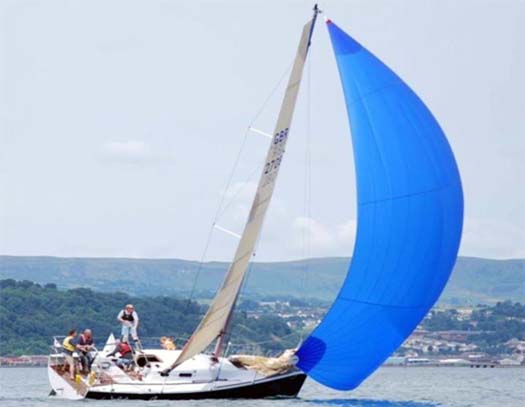
From East Antrim Boat Club at Larne, Wildwood (Ian Patterson) is a remarkable self-build project, and at just 30.5ft LOA, she is the smallest boat in the Round Ireland Race. Photo courtesy WSC
Being very much performance-oriented, Wildwood sails off a rating of 1.02, which puts her well above one of the fancied boats in the two-handed division, Kirsteen Donaldson's Solent-based X 332 Pyxis, rating at just 0.957 and a noted peformer in short-handed racing. Pyxis is just one of many entrants from the RORC heartlands around the English Channel, attracted both by the special challenge of the Round Ireland Race, and by the bonus of the points being weighted 1.4 in the RORC Championship.
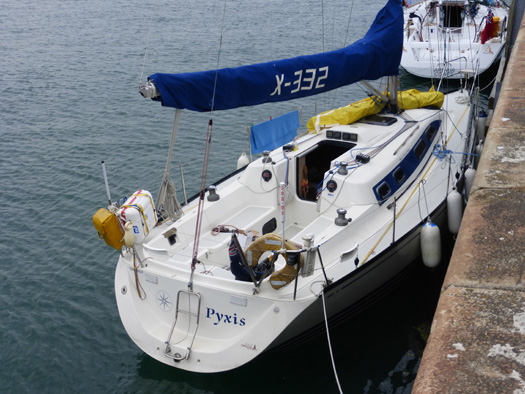
"We're here, and we're going to give it our best shot". Kirsteen Donaldson's X 332 Pyxis is a noted performer in short-handed racing in the English Channel, and was one of the first boats to arrive in Wicklow before the start. Photo: W M Nixon
With the weather forecasts indicating a sou'wester starting to reach the western seaboard by Tuesday evening, the smaller boats which can stick at it will inevitably be favoured. But the best modern offshore racers can be sailing up to their ratings with remarkably little wind, so the likelihood of another excellent overall performance by Laurent Gouy's Ker 39 should never be discounted. And the quality of the boats in the middle of the fleet is notably high, with two J/109s – Liam Shanahan's Ruth from the National, and Peter Dunlop and Viv Cox's Mojito from Pwllheli – having their performance sharpened by shaping up to Frank Doyle's similarly-rated A35 Endgame from Crosshaven.
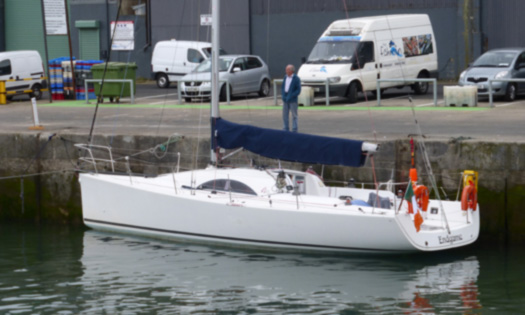
Frank Doyle's slippy A35 Endgame from Cork in Wicklow Harbour, where his father Denis began many successful Round Ireland Races with the powerful Frers 51 Moonduster........ Photo: W M Nixon
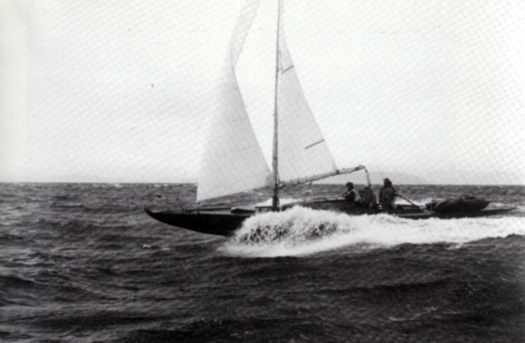
.....but it shouldn't be forgotten that Denis Doyle's offshore racing career began with the hyper-slim 30 Square Metre Vanja IV
The continuation of the name of Doyle of Cork in the Round Ireland annals is a source of special satisfaction to Peter Shearer and his team of organisers in Wicklow, as Frank's father Denis was a stalwart of the race with his Frers 51 Moonduster from 1982 until 2000. And while Moonduster may seem a memory of traditional seagoing strength by comparison with the hyper-light Endgame, never forget that Denis himself started his offshore racing with the 30 Square Metre Vanja IV, which was very austere indeed.
With each new edition, the Round Ireland Race sees increasing involvement by offshore sailing schools offering newcomers to the sport the complete introductory package, with the Round Ireland "medal" in their sailing CV at the end of it. There are several school, club and association challenge boats in the mix this year, a classic example being Irish Offshore Sailing of Dun Laoghaire's campaign with the Jeanneau Sunfast 37 Desert Star. Aboard DS, skipper Ronan O'Siochru finds himself in command of a truly multi-national and multi-cultural crew including professions as diverse as IT specialists, bakers and biochemists, and from several nationalities too – this is modern Ireland goes sailing and then some.
But inevitably, while most of the fleet will be focused on the corrected time win, line honours is where the glamour is to be found. Wicklow farmer David Ryan has leapt into the fray by chartering a Volvo 70 veteran of the 2008-2009 Volvo World Race, the Rob Humphreys-designed Russian boat which now sails the seas as Monster Project.
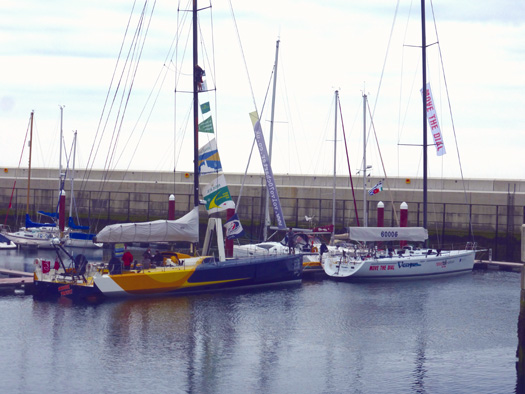
"Greystones has never seen the like of it". Heavy metal in the new County Wicklow marina, with the David Ryan-chartered Volvo 70 Monster Project, and ahead of her Joe McDonald's Farr 60 NewsTalk for Adrenalin. Photo: W M Nixon
The organizational effort involved in running the Round Ireland Race is so great for a small club like Wicklow that in some years WSC don't have an entry to call their own. But Farmer Ryan has blown this out of the water with this mighty boat, which will race with a crew of 18. So totally is this a Wicklowcentric campaign that, although the boat couldn't be berthed in Wicklow Harbour itself, she set up base camp in Greystones where the new marina came to life as another big Round Ireland contender, Joe McDonald's very handsome Farr 60 NewsTalk for Adrenalin, was also in port.
But meanwhile down in Wicklow some determined souls made sure the organising club had some presence beforehand, and both Open 40s – Kevin Rolfe's May Contain Nuts and Austin Clark's Arwen – were there on the outer pier, alongside which there also sat the vintage Volvo Ocean Team Jolokia from Lorient in France, now looking like a bit of maritime history, but a gallant performer nevertheless.

The two Open 40s at Wicklow could not have been more different in their hull style than the veteran Volvo Ocean 60 Jolokia from South Brittany (below). Photos: W M Nixon

All the special boats and everything above 55ft will be aiming at the line honours prize, and in the Teng Tools Kilcullen challenge we see a formidable project. The linkup between Enda O Coineen and Eamon Crosbie goes right back to the late great Jim Poole. Eamon was Jim's crew in the two-handed three-stage Round Ireland Race from Ballyholme in 1975, and Enda was in the strength on Jim's Half Tonner Feanor when she won IOR overall in the first Wicklow Round Ireland in 1980.
Since then, Eamon has become part of the round Ireland racing story with his successes with the Ker 32 Voodoo Chile, while Enda's seaborn interests are diverse and absorbing. But for both of them, this linkup in the chartered Open 60 Artemis represents enough new ground for fresh excitement, while continuing to utilize their unrivalled experience.
They've decided to race with a total crew of seven, including metman/routing expert/Open 60 veteran Wouter Verbak. The other four in addition to the joint skippers are Mark McGibney, Andy Greenwood, Greg Parker and Alan Crosbie, the latter fresh from sailing on Quest, the overall winner of the ICRA Nats.
It's undoubtedly a crew of all the talents, and if the weather performs as expected, at 1400 hrs today we can expect to see the likes of Monster Project and Teng Tools Kilcullen streaming away from Wicklow in formidable style while the smaller boats bob in their wakes. But as many who have raced round Ireland or indeed just cruised round will know, the Atlantic seaboard can seem to be one very long bit of coastline when the wind is light from ahead. For little boats, knowing there are sou'westers advancing slowly from the ocean, it may well be a case of everything coming – and coming right – for those who wait.
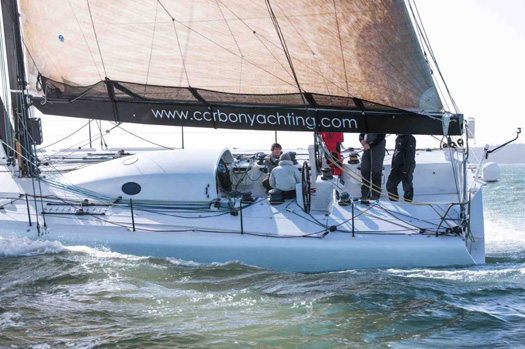
Teng Tools KIlcullen is being sailed by one of the most talented crews in the Round Ireland Race 2014.
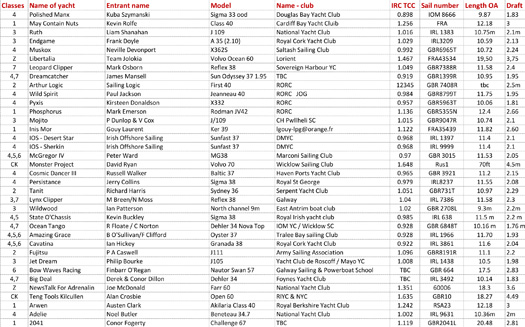
Round Ireland Entry list 2014
Ireland's Oldest Wooden Boats Aren't Getting Any Younger
#woodenboats – On Midsummer's Day, W M Nixon looks back on the already busy and event-filled Irish season of 2014, and reflects on the extraordinary longevity of some boats, their remarkable variety, and the diverse characters who own them.
When I shipped aboard the former Bristol Channel Pilot cutter Madcap to sail the Old Gaffers Division in Howth Yacht Club's Lambay Race on June 7th, it wasn't the first time I'd been out and about on a boat built in the 1870s. But as most of my experiences on John and Sandra Lefroy's 1873-vintage iron-built classic 58ft Victorian steam yacht Phoenix on Lough Derg took place in the 1970s with the most recent jaunt being way back in 1982, sailing on the Madcap was indeed the first time afloat in a boat built 140 years ago.
It takes an effort to get your head around the most basic notion of such an age. You find yourself reflecting on the delights that still awaited the human race at the time, things that were still far into the remote future in the 20th Century. During the 1870s, industrialisation was still gaining traction, but the very idea of warfare on the industrial scale which was to be experienced in the Great War of 1914-18 was beyond most people's imagination, and way beyond anyone's experience. That said, there were more than enough other ways of experiencing an early death, with a range of particularly unpleasant illnesses which have been largely eliminated today.
Yet it was increasing industrialisation which created the circumstances that enabled both boats to be built. The Bristol Channel Pilot cutters evolved rapidly in the latter half of the 19th Century in order to provide pilots for the more numerous and increasingly large ships which were coming into ports such as Cardiff and Bristol. They reached their peak of performance around 1900, by which time they'd achieved a remarkable stage of development, being fast and able, yet comfortable at sea, and capable of being handled by a very small crew after the pilots had been delivered to incoming vessels. When their working days were over as they were replaced by motorised vessels, they proved ideal as seagoing cruising yachts.
There was nothing work-oriented about the pleasure yacht Phoenix when she was built to the designs of Andrew Horn in Waterford in 1873. Or maybe that's being a bit naïve. After all, she is down as having been built by and for the Malcolmsons of Waterford. They were a remarkable clan who brought many industries to Waterford in the 19th Century, and they created the miniature industrial town of Portlaw westward from the city, off the south bank of the Suir Estuary.
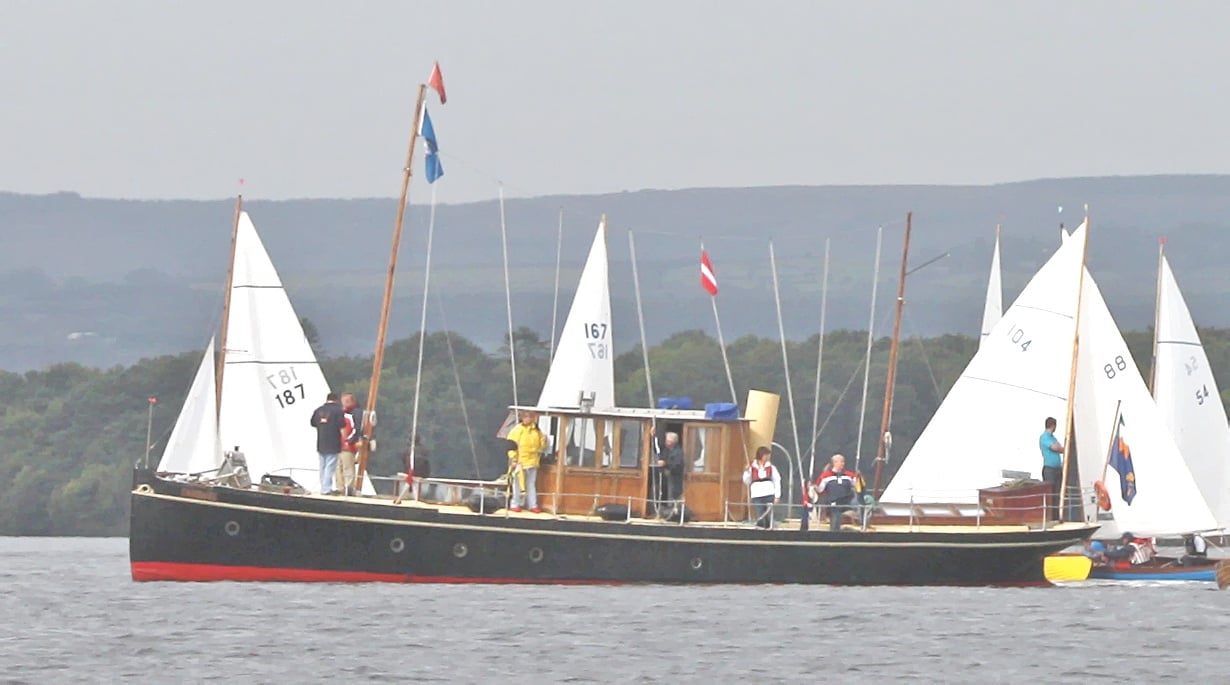
The 58ft Phoenix, iron-built in Waterford in 1873, performing Committee Boat duties at Dromineer for Lough Derg YC. Photo: Gerardine Wisdom
So in building the Phoenix themselves, so to speak, they were creating a subtle advertisement for Waterford expertise, with this new miniature of an ocean liner being constructed in the highly-regarded Lowmoor iron. And she's a powerful statement - this lovely old vessel has lasted much better than many of the Waterford enterprises which outshone her at the time of her building, so much so that if, in Waterford's current recessional woes, they sought something to symbolise what the city is capable of, they would do worse than put some resources the way of the Phoenix for her continuous maintenance.
Five years ago she made a very stylish appearance as the Committee Boat in a classics regatta at Dromineer, and that in turn produced an astonishing photo which included Ian Malcolm's 1898-built Howth 17 Aura. It was the first time a jackyard topsail had been seen on Lough Derg since before the Great War, and all that together with a raft of Shannon One Designs (which date from 1922 onwards) and a fleet of Dublin Bay Water Wags from 1902 onwards meant that the total age of the boat in the photo was pushing towards the 2,000 years mark.

Phoenix and the 1898 Howth 17 Aura (Ian Malcolm) at Dromineer with rafts of Shannon ODs and Water Wags. The combined age of the bots in the photo is well over a thousand years. Photo: Gerardine Wisdom
To be aboard Phoenix is to be transported right back to the 1870s, as she has a beam of only 10.5ft, which on a length of 58.5ft make for one very slim and potent hull. She has long since had her original steam engine replaced with a diesel, and back in 1982 when I was last afloat in her, it was October, and we were the Committee Boat for the annual IYA Helmsmans Championship, raced that year in Shannon One Designs with Dave Cummins of Sutton the winner, crewed by Gordon Maguire.
Being late season, the Phoenix's injectors needed a clean, but as the Race Officers were those perpetual schoolboys Jock Smith and Sam Dix of Malahide, they were delighted by the Phoenix's ability to emit a fine plume of smoke from her funnel at full speed, and after the championship was resolved they tore across the lively waters of Autumnal Lough Derg at full speed while – from another boat - I grabbed some photos which made Phoenix look like a destroyer in action at the Battle of Jutland. One of them subsequently appeared as the cover of Motor Boat & Yachting, and as I seem to have mislaid the colour slides, if anyone has a copy of that particular edition I'd much appreciate a scan of it.
Moving on from the 1873-built Phoenix in 1982 to the 1874-built Madcap in 2014 is quite some saga, but we'll edit it by sticking to events this year revolving around the developing annual Old Gaffer programme in the Irish Sea. Last year Dickie Gomes' 1912-built 36ft John B Kearney yawl Ainmara from Strangford Lough won the inaugural Leinster Trophy race in Dublin Bay which marked the OGA's Golden Jubilee, and she did it despite now being bermuda rigged. But as she was returning to her birthplace in Ringsend for the first time in 90 years, she was treated as an honorary gaffer.
Honour being the theme of things, this meant we were honour-bound to bring her south again to defend the Leinster in 2014, but this was given an added impetus by a plan to link up in Dun Laoghaire with Martin Birch's 1902-built Espanola out of Preston in Lancashire. From 1912 until 1940, the 47ft Espanola was a feature of the Royal Irish YC in Dun Laoghaire, owned by noted sailor Herbert Wright, who in 1929 became the founding Commodore of the Irish Cruising Club when he cruised Espanola with four other yachts to Glengarriff where the ICC was founded on July 13th 1929. The Espanola links, together with the fact that the RIYC is now in partnership with Wicklow Sailing Club in hosting the fleet for the biennial Round Ireland Race, made for a fortuitous combination, as Dickie Gomes of Ainmara was Mr Round Ireland between 1986 and 1993, when he held the open Round Ireland Record and also had been overall winner of the 1988 race.

Espanola as she was in 1929, when Commodore's yacht at the founding of the Irish Cruising Club
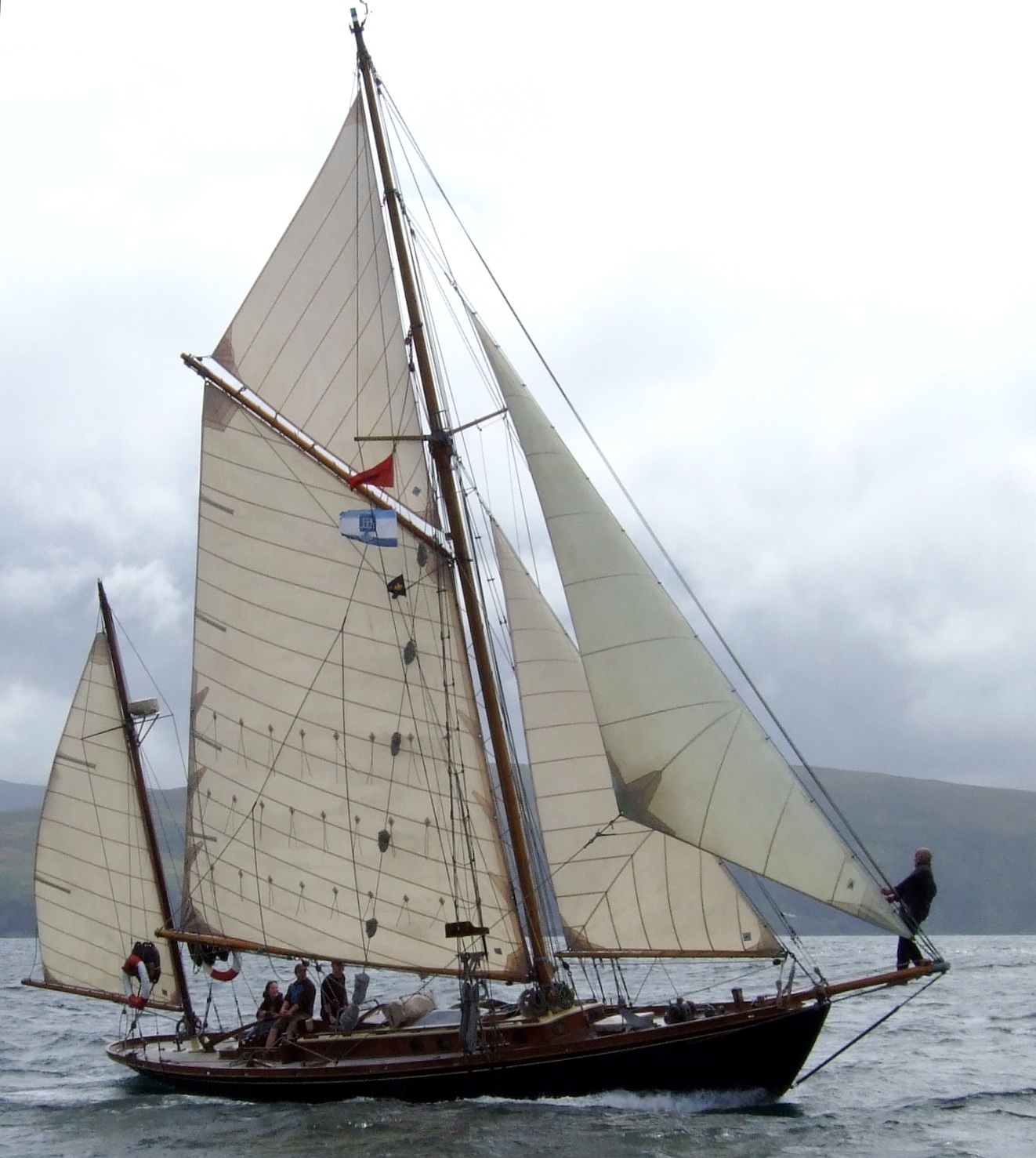
The 1902-built Espanola as she is today
Thus all the stars were in alignment for an historic and convivial meeting of the two old boats at the RIYC on the evening of Friday May 30th, the night before the Leinster Plate race was due to start just round the corner in Scotsmans Bay. But while stars may have been in alignment, ducks failed to get into a row, as Espanola with her exceptional draft of 7ft 6ins failed to get out of Preston over the shallow bar in the one tide which would have suited, on May 16th.
This situation is a useful illustration of the problems the old gaffer people face in keeping the show on the road with limited resources. Martin Birch, having been a lecturer in Lancaster University, had found Preston's little marina an ideal place to keep and maintain Espanola, and the marina in turn regarded the old girl as their pet boat. But Preston is longer a busy commercial port, so the channel has been left to is own devices, and with the huge tides of the Lancashire coast, getting Espanola to sea is quite a challenge as sometimes there's only one day in any month when it can be done.
So there we were, faced with the prospect of Hamlet without the Prince with just ten days to go to the historic gathering at the RIYC. But Jim Horan, affable Commodore of the Royal Irish YC, took it all in his stride and told us to bring Ainmara along anyway, it would be a good excuse for a Friday night party and he was keen to meet the skipper who had made the Round Ireland challenge very much his own 28 years ago.
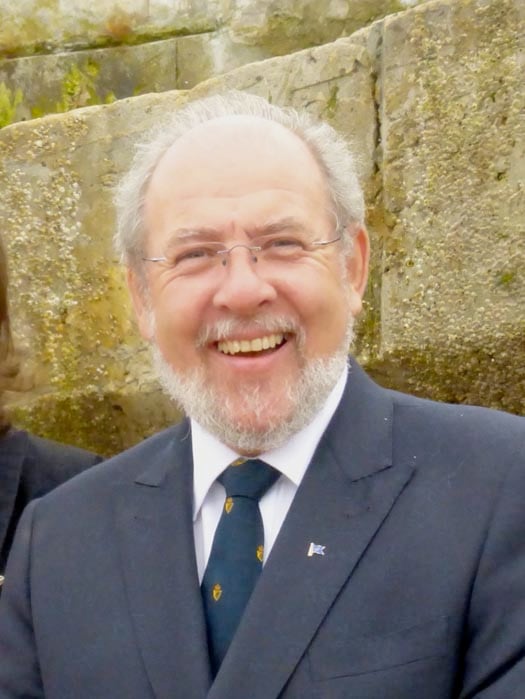
Jim Horan, Commodore of the RIYC, told us to come on and be welcome even though Espanola couldn't make it. Photo: W M Nixon
With the foul weather of mid-May, while Ainmara had got afloat from her winter quarters in a hayshed at the Gomes farm on the Ards peninsula in County Down, further fitting out was difficult in endless rain, and the skipper came down with a massive cold. But then the weather perked up, and he did too, so at lunchtime on Thursday My 29th we headed down Strangford Lough from the Down Cruising Club's former lightship headquarters at Ballydorn to catch the start of the ebb in Strangford Narrows at 1430 hrs.
Progress was good with a light to moderate nor'easter, but Ainmara and her crew (there were four of us – Brian Law, Ed Wheeler and I together with Dickie) have got to the stage where nights at sea are regarded to be the result of bad cruise planning. Yet if we were going to be comfortably in Dun Laoghaire for Friday evening, then only Port Oriel at Clogherhead made sense as an overnight. But Port Oriel, home to some of the best-maintained fishing boats on the coast, can become a very crowded place on a Thursday night.
However, a phone call to the uncrowned king of Clogherhead Aidan Sharkey – whom I'd first met back in the 1980s when our two boats were moored in Seal Hole at Lambay, where he was diving on the nearby 1854 wreck of the Tayleur - ensured there'd be a berth for us, and when we arrived in at sunset there was the man himself to direct us to a corner where we wouldn't inconvenience fishing boats, and moreover had access to a set of proper steps.
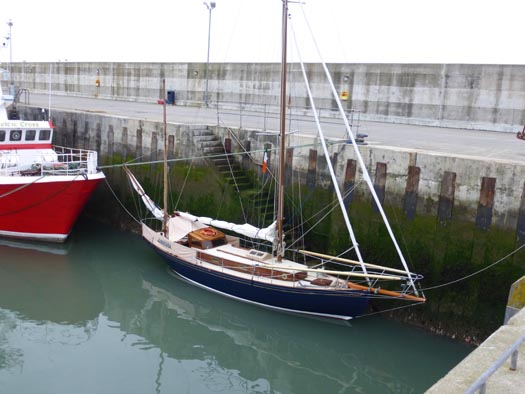
Port Oriel at Clogherhead provided Ainmara wih a handy overnight stop. There was more space available (below) as most of the 30-strong local fleet were away fishing the south coast. Photos: W M Nixon

Aidan's commitment to the maritime life is total. He's of an old Clogherhead fishing family, and he and his late brother Feargal were the backbone of the local beach-launched lifeboat crew. The banter was mighty on board Ainmara, leavened with tales of lifeboat experience which would curl your hair. The laughter through the companionway attracted others board, and soon Sean the razor clam man (all of his catches go straight to China) was in the hatchway with glass in hand, and when we asked where we might get a new deck scrub first thing in the morning as somehow the ship's own one had gone AWOL, Sean said not to worry, he'd throw one on board, and we could just leave it on the big fishing boat beside us as we left next day.
Ashore, I went up to Aidan's house in the village as he'd said he'd something to show me, which was an understatement. He was into the diving much earlier than most, thus when he got to wrecks which today are known to everyone, there were still intact bits of the cargo to be salvaged. Most east coast divers have fragments of chinaware, pottery and other artefacts from the Tayleur, but Sean had so many complete pieces, together with many other items of special antique value from other wrecks mostly in Donegal, that he would be well able to provide complete afternoon tea for the entire choir, all served on 1840s china. But it wasn't tea I got in the Sharkey household, it was Aidan's present of a large bag of fresh crab claws, and a selection of his own-cured salmon – smoked and gravid lax both – which sustained us through the next day's sail.
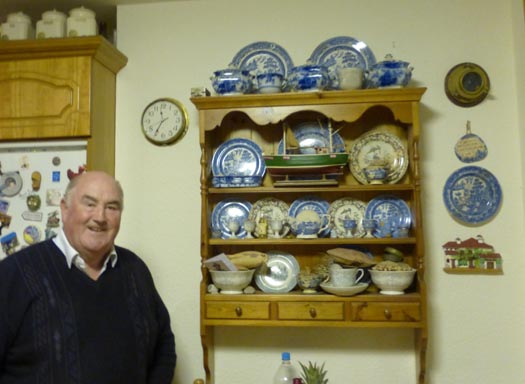
Aidan Sharkey of Clogherhead with some of his remarkable collection of salvaged chinaware. Photo: W M Nixon

The sort of sailing cruising folk dream of. Ainmara shaping up nicely to take the first of the fair tide through the islands at Skerries. Photo: W M Nixon
The morning brought the welcome gift of a decent little sunny east to nor'east breeze, and a lovely beam reach all the way down to Dublin Bay, with the south-going tide caught to perfection at the Skerries islands (and yes, I know it's superfluous to talk of the "Skerries islands", but that's what they're called to differentiate them from the Skerries off Holyhead).
Anyone who was involved in last weekend's ICRA Nationals at the Royal Irish YC will know how this premier club can lay on the welcome with effortless style. In the last weekend of May, Ainmara and her crew had the Royal Irish treatment all to themselves. Sailing Manager Mark McGibney ushered us to the prime berth right at the club where we found ourselves in a miniature maritime museum, with the Quarter Tonner Quest close astern (she was to become the ICRA National Champion a fortnight later), while just across the way was the S&S 36 Sarnia – back in 1966, the Sisk family set Irish sailing alight by bringing this very up-to-the-minute fin-and-skeg fibreglass boat back from builders Cantiere Benello in Italy, where they'd started series production on this ground-breaking Olin Stephens design before the same hull shape became better known as the Swan 36 built by Nautor in Finland.
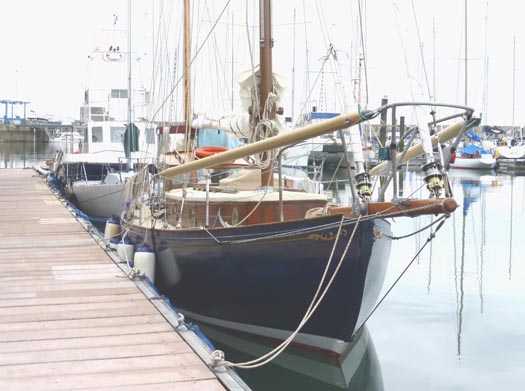
"Maritime museum" at the Royal Irish YC. Ainmara (built Ringsend 1912) with the 1987 Quarter Tonner Quest astern, and the 1966-built S&S 36 Sarnia across the way in her marina berth. Photo: W M Nixon
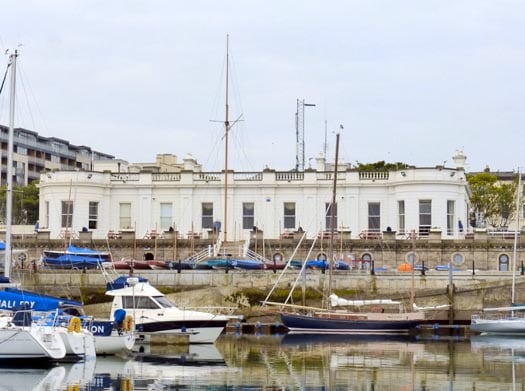
It has to be one of the best berths in the world. Ainmara at the RIYC – it's early morning, and the flags aren't yet hoisted. Photo: W M Nixon
The hospitality flowed seamlessly as the late afternoon graduated into evening and then velvet night. Ainmara is an extraordinarily effective calling card, and the stream of entertaining visitors brought laughter aboard before the Commodore moved us all up to the clubhouse and a fine supper and much chat with Michael O'Leary, one of the most visionary minds in Irish sailing, and his wife Kate and her people with tales of how she and longtime friend Clare Hogan are in the thick of things in the very healthy Water Wag class.
The RIYC took all this in its stride despite the fact that there was a big wedding going in the clubhouse at the same time, but it all went so smoothly that at one stage Ainmara's crew found themselves being invited to join in the wedding celebrations. However, we demurred because we were athletes in training for the Leinster Trophy next day, yet nevertheless certain key players in the wedding got themselves aboard Ainmara at a very late hour.
The plan for Saturday had been changed, but we were right up to speed with this as Denis Aylmer, the RIYC's key man in the OGA, had told us over a convivial pint that the likelihood of light winds had meant that Race Officer John Alvey had moved the scene of the action from Scotsmans Bay to a more compact race area close off the entrance to Dublin Port. It was all grist to our mill, as we could make an early morning departure and head up to Poolbeg Y & BC across a mirror-like bay, lining up the crew to salute the North Bank Lighthouse in the River Liffey, as it's something of a memorial to John B Kearney, whose day job was in the engineering department in Dublin Port and docks. With his original lighthouse, he pioneering a technique of screwing the piles into the seabed. You'd have thought an air of reverence would prevail, but with Ainmara's crew of anarchists, straight faces could only be maintained for about 12 seconds.
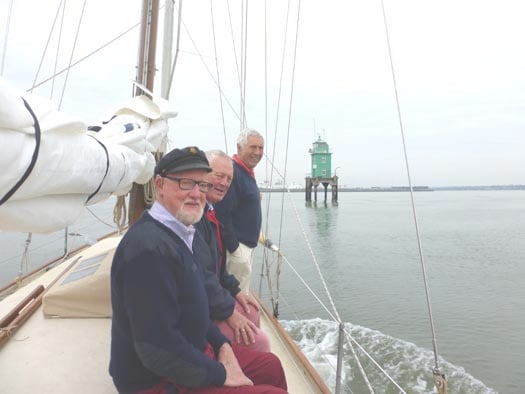
Trying to look appropriately reverential. Ed Wheeler, Brian Law and Dickie Gomes approaching Dublin Port's North Bank Lighthouse on which John B Kearney pioneered the use of screw piles. Photo: W M Nixon

"We're only here for the breakfast". Katy O'Connor's excellent catering in Poolbeg Y & BC is deservedly popular among visiting crews. Photo: W M Nixon
While we wanted to be well on time for the pre-race briefing, the main reason for getting promptly to Poolbeg was to take full advantage of Katy O'Connor's legendary breakfast at the club, and we put away enough calories to keep us going all day. At the briefing, John Alvey told us the committee were concerned that the very varied fleet – everything from Ainmara to the big Naomh Cronan, a superb Clondalkin-built re-creation of a Galway Hooker – included some boats which, in the light airs expected, could be out on the bay until nightfall.
So the plan was for a short race taking in several marks so that it could be finished at the end of any leg. But by the time we got down to Dublin Bay, it was crisp blue with a smart little sea breeze filling in to give sailing conditions which suited Ainmara to perfection, yet some of the heavier gaffers were still lumbering slowly about in what to them was a light wind.
They may have been lumbering about, but several were very determined to make a sharp start right on the committee boat. Anyone accustomed to quick-turning and fast-accelerating modern boats will find a fleet of traditional and classic gaffers a real education. They take time to get moving, they take for ever to stop, you point them a long way out, and their bowsprits – "dock probes" as marina managers call them – seem intent on skewering everyone else.
But while our skipper may pretend to be just an old cruising man these days, his racing blood was up. We set ourselves to sweep into what we hoped would be a gap starting to appear at the committee boat seconds after the start signal. We consoled ourselves with the thought that in extremis, we might just manage to shoot head to wind leaving the committee boat to port, ruining our start perhaps, but preserving the Ainmara intact.
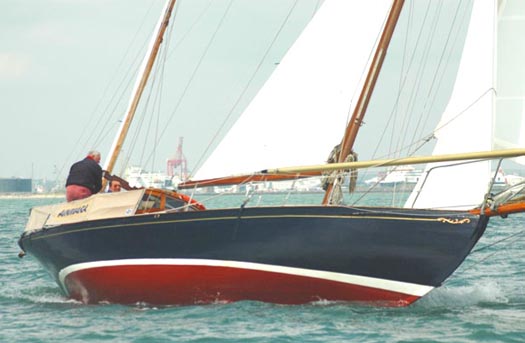
"Go for it, and let's hope there's a gap when we get there..." Ainmara starts to build speed towards her start in the Leinster Trophy Race 2014 . Photo: Gill Mills
So she was set at it, despite attempts to slow her a bit the speed built up, but as quickly as I'm telling this the gap started to appear and she zapped into it and just managed to keep her wind clear on Sean Walsh's remarkably fast Heard 28 Tir na nOg and Denis Aylmer's Mona. Now we had to find the DBSC marks in the right sequence, but Ed was on top of it feeding co-ordinates and giving out courses, we found that with a bit of luck we might just lay the first mark close hauled, and though Tir na nOg – whose waterline length is much the same as Ainmara's – hung in very well, he'd to tack for the mark while we scraped by it, so after that it was up jib tops'l and making hay.
But though we took line honours, we felt certain Tir na nOg would win on corrected time, as a Heard 28 sailed as well as she is can be one very potent performer, and Sean seemd to be still right on our stern at the finish. The results wouldn't be announced until Monday evening, so that Saturday afternoon we wandered back upriver to Poolbeg in sunshine so powerful that an afternoon zizz was your only man, and then we emerged on deck to find that others were arriving in port, with one of the the Welsh visitors, the engine-less Happy Quest from Milford Haven, making a copy-book job of berthing under sail, and then all was alive with the Howth Seventeens arriving in from their home port after a very close-fought passage race which had been narrowly won by Conor Turvey sailing Isobel.

Happy Quest from southwest Wales lives up to her name with a successful berthing under sail only at Poolbeg. Photo: W M Nixon
The Seventeens were there to put on a display race next day (Sunday) in the Liffey as part of the three day Dublin Port Riverfest over the Bank Holiday weekend. Inevitably for those of us who took part in the first one in 2013 when the OGA Golden Jubilee was top of the bill, there wasn't quite the same buzz, but first-timers watching aboard the restaurant ship Cill Airne assured us they found it very exciting indeed, and were especially impressed by the waterborne ballet of the two big harbour tugs Shackleton and Beaufort, while the funfairs and entertainment shows along the quays really did provide something for everything.
Once again the very sight of the Seventeens – which we in Howth tend to take for granted – was fascinating in the city setting. Though the promise of a decent breeze evaporated, Race Officer Harry Gallagher managed to get enough in the way of results to declare Peter Courtney with Oonagh the winner, an appropriate result for an historic class making a show performance, as the Courtneys have been involved with the Howth Seventeens since 1907.
I watched it all from an appropriate setting, aboard the Dutch Tall Ship Morgenster, a handsome 150ft brig which should be required visiting for anyone promoting the idea of a new Tall Ship for Ireland. For the Morgenster – which was re-configured as a sailing ship in 2009 – is run as a commercial venture, and can pay her way through being the right size to be a business proposition, helped by being based in the Netherlands. Thus she has a vast continental catchment area nearby to attract trainees of all ages and abilities who are prepared to pay enough for berths to keep the show efficiently on the road. There are several Dutch-based tall ships run in the same way, and the message is that if you're going to make a go of it commercially, you have to have a large enough and readily-accessed market to make it viable, and you need a boat big enough to carry sufficient trainees relative to the size of the ship – 36 in Morgenster's case – to balance the books.
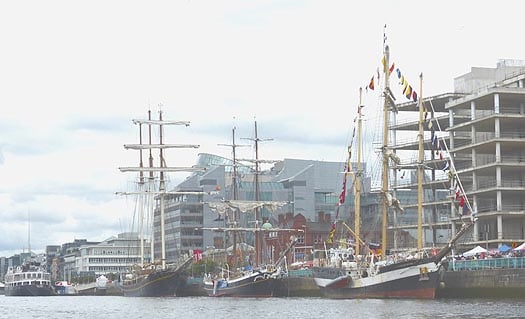
Tall ships in the Liffey, with the commercially-run 150ft sail training big Morgenster at centre. Photo: W M Nixon
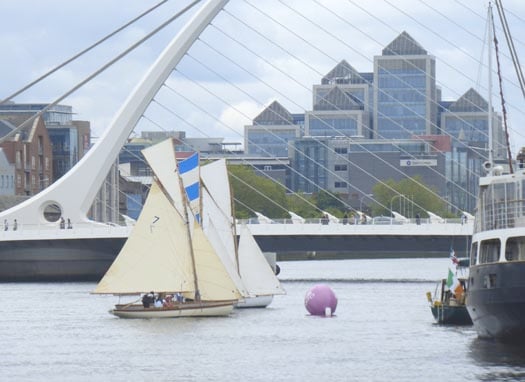
Sails and the city – Howth 17s at the Sam Beckett bridge Photo: W M Nixon
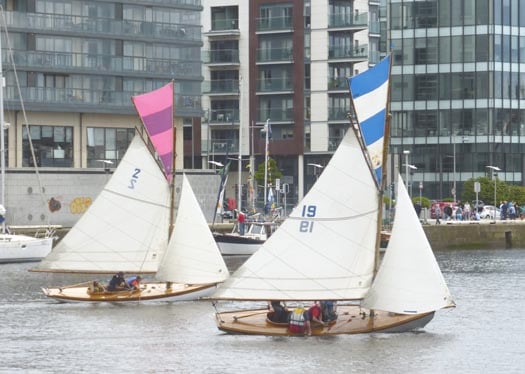
There was just enough wind for the first race for the Howth 17s to show what they could do in the Liffey if the breeze held up. Photo: W M Nixon
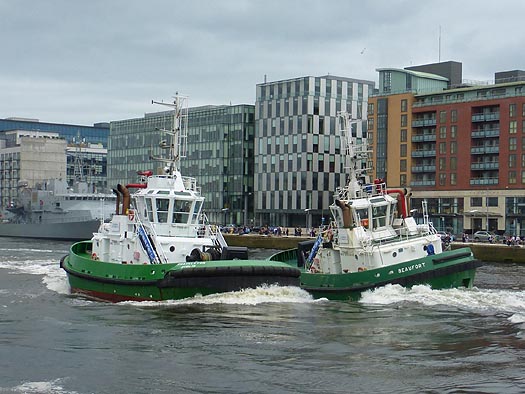
The Dublin Port tugs have awesome power to deploy in their waterborne "ballet" Photo: W M Nixon
But enough of solemnity. We went downriver again for farewells at Poolbeg, and then away across Dublin Bay and round the Baily for a seafood feast in Howth at the new place Crabby Jo's, and a handy overnight stop before using a good westerly next morning to give us a push towards Ardglass where we needs must stop, as the tides into Strangford Lough are a door slammed shut every six hours. But as ever, Ardglass's convenient and friendly little marina provided the perfect decompression chamber, and up in Mulherron's the crack was mighty with the crew of the famous restored Manx longliner Master Frank, just the two of them with skipper Joe Pennington - aka The Rat – being crewed by a psychiatrist who claimed to be strictly on holiday, but we did wonder, as any gathering of Old Gaffers is better than a wardful of nutters.
Ainmara's mini-voyage concluded next day with a text message from Dublin to tell us we'd retained the Leinster Trophy, which surprised us, and then with an idyllic sail in a sunny sou'wester, everything set to the jib tops'l, and all sail carried right through The Narrows, across Strangford Lough and thorough Ringhaddy Sound, and on across a blue sea among green islands past tree covered shores until we handed the sails just off the entrance to Down Cruising Club's isle-girt outer anchorage immediately south of Mahee Island, in a little sheltered area which has somehow acquired the unlovely name of Pongo Bay.

Home again. Ainmara back on her mooring in Strangford Lough, with Brian Law's classic yawl Twilight astern. Photo: W M Nixon
There, Ainmara is securely moored close to Brian Law's own cruising boat, the beautifully restored classic Lion Class yawl Twilight, designed by Arthur Robb. Like Dickie Gomes, Brian does all his own boatwork in a hayshed beside the house. So closely intertwined are their interests that they readily crew for each other, and of course the exchange of information and assistance and re-fit ideas is continuous.
And there's one further fact about these guys which may be of interest to other cruising crews. Aboard Ainmara during the three seasons in which I've cruised on her since she was restored for her Centenary in 1912, there's no kitty to cover expenses. There's an underlying feeling that as the skipper provides the boat, the crew owe him on a permanent basis. Thus if we get into a port and there's a choice between a comfortable marina berth or hanging off a quay wall, the crew will simply slip away and discreetly pay for a marina berth, and then tell the skipper it's a done deal.
Equally, when ashore for a meal, one of the crew will usually sidle off and pay for everyone when no-one else is looking. But if the skipper thinks the day has gone particularly well, you'll sometimes find he's paid for it all himself, As for getting diesel, whoever is carrying the cans will pay for it himself. Then too, when stores are required, it's covered by whoever goes to get them. It all sounds like an accountant's nightmare, yet so far, somehow at the end of the cruise everyone is content with the feeling that it has all balanced out, and as it has worked well for three years and longer, the attitude is that if it ain't broke, then don't try and fix it.
It had been hoped that Ainmara could stay on in the Dublin area for a week to do the Howth YC's Lambay Race in the Old Gaffers division on June 7th, as she won it in 1921. However, there was too much work still to be done to get her completely ready for a busy cruise programme coming rapidly down the line. But as she'll have to be back next year to defend the Leinster Trophy again, who knows but the double event might be done in 2015. As it was, her need for further fitting-out nearer to home was the saving of me, as a mighy temptation arose. The ancient Madcap from the north had stayed on in Dublin Bay, and was doing the Lambay Race with other old gaffers. The word on the waterfront is that Madcap may well be sold to France to be the centrepiece of a maritime museum in La Rochelle. So the Lambay Race might well be the last chance to sail on a 140-year-old boat. A place was secured on board.

The gaffers gather......Tir na nOg, Madcap and Naomh Cronan on misty morning in Howth before the Lambay Race. Photo: W M Nixon
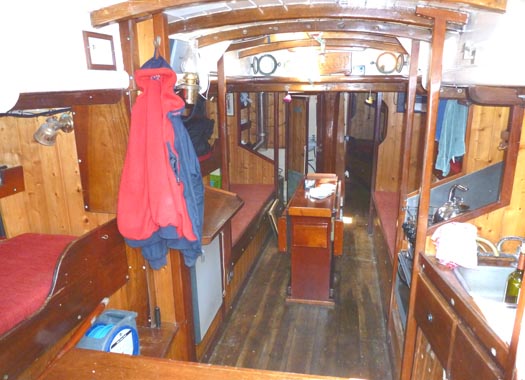
Madcap's sensible accommodation (above and below) reflects the seagoing needs of the pilots for whom she was built140 years ago. Photo: W M Nixon
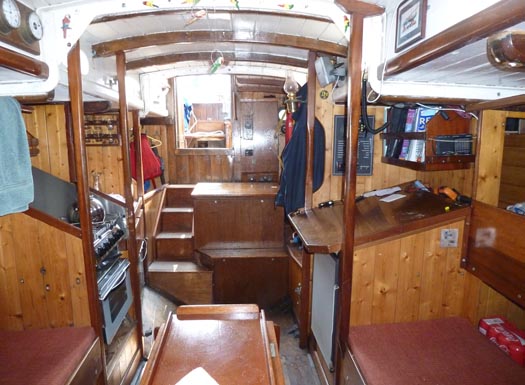
Madcap's owner for more than twenty years now has been Adrian "Stu" Spence, a rugged Belfast barrister who has the essential determination to keep such an ancient boat going. And going places too – he has been to Greenland and several times to Spain and Brittany, and has brought his old cutter through many a problem to log an impressive voyaging record.
If you have a boat of this age, your motto is: When God made time, he made a lot of it. Thus although the Old Gaffer's division was due to start at 1135, five minutes after the Howth Seventeens had set off through Howth Sound to sail the traditional Lambay course leaving Ireland's Eye to starboard and Lambay to port in order to celebrate the centenary of the Lynch family's Howth 17 Echo, it was pushing 1140 by the time we mde our leisurely debut to follow other other gaffers, which had Sean Walsh's keenly-sailed Tir na nOg soon disappearing into the misty asterly, followed by the Galway hooker Naomh Cronan helmed by the great Paddy Murphy of Renvyle, the Cornish crabber Alice (Mark Lynch) and then Madcp in her own good time.
With Northern Ireland Old Gaffers Association President Peter Chambers on the helm, Madcap settled gently into her stride, showing that she needs very little steering – she'll maintain a straight line for miles without the wheel being touched or secured in a any way. It's an oddly soothing characteristic, just the thing to calm a man down after a hectic week in the High Court, and she soon was making her own best speed with a bit of bite now in the breeze, putting Alice astern and keeping Naomh Cronan handily in touch.

"Is it always this foggy off Howth?" Stu Spence and Peter Chambers with he visibility closing in during the Lambay Race. Photo: W M Nixon
The mist became fog, but as ever it was difficult to tell just how thick it was until we suddenly found ourselves surrounded by wraiths in the gloom. It was Class 0 racing towards Lambay, and overtaking us just feet away, giving dramatic close-ups of some of the most likeable boats on the East Coast, with Stephen O'Flaherty's Spirit 54 Soufriere pacing it with Chris Hourican's First 47.7 Pretty Polly and the Tyrrell family from Arklow with their handsome J/122 Aquelina.
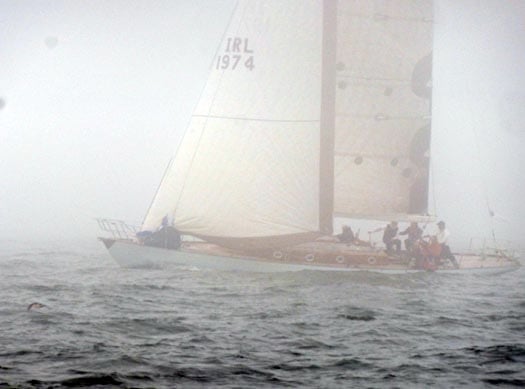
Do not adjust your sets, it really was this foggy for a while. Stephen O'Flaherty's Spirit 54 Soufriere in the fog during the Lambay Race Photo: W M Nixon

Chris Hourican's First 47.7 Pretty Polly in close-up Photo: W M Nixon
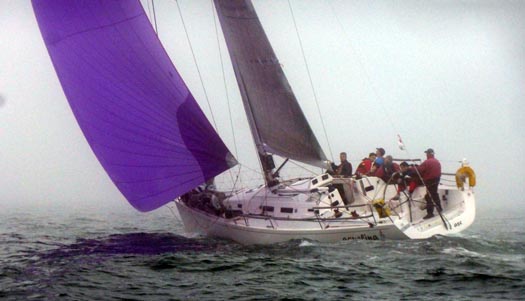
The Tyrrell family's J/122 Aquelina looking her best as she slices through the fog. Photo: W M Nixon
The fog was lifting as we got to the island with boats everywhere – the gaffermen were most impressed. Naomh Croanan had been overtaken, and Peter found us the perfect track along the flukey north side of Lambay, with Madcap effortlessly sliding over the smooth sea on a dead run and apparently consolidating her position.
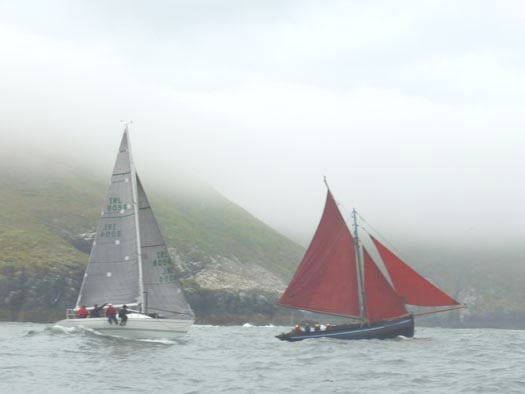
The fog start to lift. Dave Cullen's Half Tonner King One and te Naomh Cronan pproaching the east point of Lambay. Photo: W M Nixon
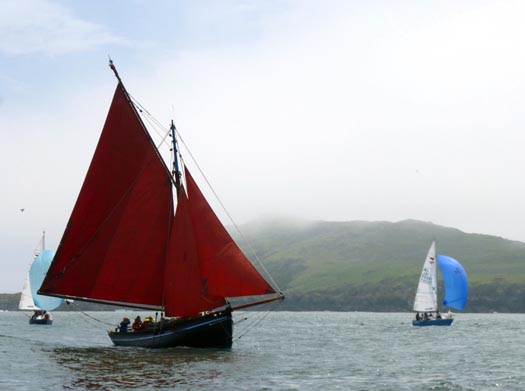
It could be Connemara...., .Naomh Cronan and two Puppeteer 22s off the north coast of Lambay Photo: W M Nixon

The long haul to the finish, the sun is out, and the breeze is beginning to develop enough power to suit Madcap. Photo: W M Nixon
But that was only until we started to head south back to the finish in Howth Sound. The Bermudan boats could lay it, so could the Seventeens, but poor old Madcap was even outpointed by Naomh Cronan, which Paddy Murphy very skilfully kept inside the line of foul tide in Lambay Sound and began to nibble at our lead, while we sagged to lee.
The sun was out, the sailing was lovely, we were surrounded by bustling classes of Puppeteer 22s and Ruffians 23s, and I suggested that a bit more tension in the jib luff, might do the trick, only to be told that as the bowsprit was no more than a liberated telegraph pole, it wasn't really up to the loads which would be put on it by trying to maximise the performance of a 22-ton boat, and nobody wanted splinters flying every which way aboard a boat where the mainboom looked to weigh at least half a ton.
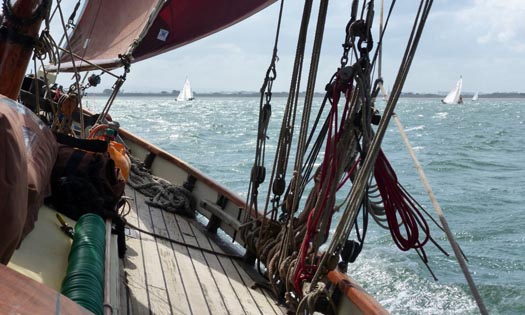
A bite to the breeze, with little boats everywhere – and all of them on starboard. Photo: W M Nixon

The Dun Laoghaire Ruffian 23s made a weekend of it for the Lambay Race, coming over on the Friday night, partying mightily, and then going out to race on Saturday in a rising breeze. Photo: W M Nixon
As it is the loads becme quite something as the breeze freshened sunny and squally down the north flank of the hjill of Howth. By the time we made it across the line, Madcap was going well on smooth water under just mainsail and staysail. But though Naomh Cronan was still ahead and rightly delighted with themselves at getting a good second, it was Tir na nOg which had been in race of her own. Yet as Sean Walsh reported with astonishment, he hadn't been able to get among the slippy little Howth 17s, where John Curley and Marcus Lynch had a good win with Rita, Howth Seventeen No. 1.
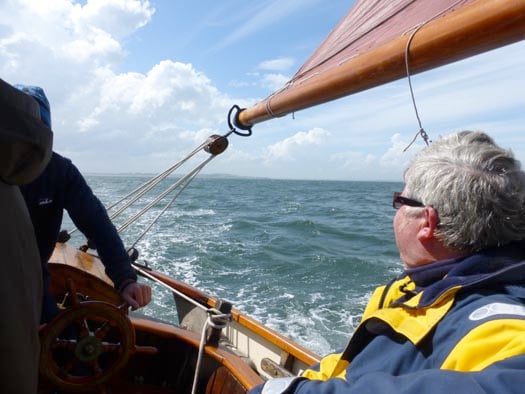
Finally there was enough breeze for Madcap's wake to stretch satisfyingly astern while she could point better with the jib brought in, but Naomh Cronan still finished ahead to take second prize. Photo: W M Nixon

The mighty helmsman of Renvyle. Paddy Murphy (left) steered Naomh Cronan to an excellent performance in the Lambay Race 2014. With him is DBOGA Hon Sec Gerry Murtagh with a trophy he won racing round Lambay in 1986. Photo: W M Nixon
It seemed an Old Gaffers Classic Lambay Race had been inaugurated, and Sean Walsh, international President of the OGA, was most appropriately the first winner. It was something to celebrate, and it duly was, in the sunshine at Howth YC. But in time, I had to take myself away and go for a long walk with the little dog along the beach. For when you've been sailing on a 140-year-old boat, there's a need to ponder the passing years, and this crazy sport of ours in which museum pieces are part of the action.
The Spirit of James Bond Will Sail On In Dublin Bay
#cruiserracing – The three day ICRA Nationals begin next Friday (June 13th) at the Royal Irish YC in Dun Laoghaire. The entry of one hundred and eleven boats from all parts of Ireland will inevitably see the numbers emphasis on the large home fleet, but W M Nixon reckons this will make the visiting rock stars try even harder.
The Spirit 54 Soufriere would attract admiring attention in any fleet. And under Stephen O'Flaherty's enthusiastic ownership, she has frequently made the scene - often with racing success – in classic yacht events. Nevertheless, to take this long and shapely beauty into the cut and thrust of Ireland's top national cruiser-racer championship is a truly sporting gesture. But as a star in a James Bond movie, Soufriere is accustomed to mixing the rough with the smooth.
It was in Casino Royale (2006) that Soufriere made her debut on the Tinseltown stage, sailing serenely into Venice with Daniel Craig as 007 taking the helm from co-star Eva Green. But it's far from the sheltered waters of the Serenissima that Soufriere will be competing in six day's time, yet her crew and the hundreds of other sailors who are shaping up for the ICRA Nationals 2014 on Dublin Bay will be hoping for a happy mix of good weather and decent sailing breezes to put away some high quality sport.
With six days to go, forecasters are reluctant to firm up their opinions on the expected state of the fickle Irish weather, particularly as it operates in the peculiar climatic laboratory which is Dublin Bay. But the folk who put their faith in anticipated Polar Jetstream movements are encouraged by fairly clearcut suggestions that this indicator and activator of our meteorology may finally be moving northwards towards its proper summer position by next weekend. But whether or not it does so in time to significantly benefit the ICRA Nationals is currently a moot point.
Whatever, the most recent charts we've seen have been showing a marked tendency towards southwest to northwest winds six days hence. You might well think that would provide a steady breeze coming down the Liffey Valley and out across the bay for splendid sailing on relatively smooth water. But as dear old Dublin town heats up with the summer temperatures building towards Bloomsday on June 16th, all sorts of quirks can be introduced into the weather, with afternoon sea breezes with varying touches of east in them playing havoc across the underlying gradient.
As for the Jetstream, the least we can hope for is that it won't be lying across Ireland. Ideally, its underlying path will be swirling away northwards. But if it has settled down unseasonably far south to make life disagreeable in northwest Spain or even across France, then we might just get lucky, as Scotland was in 2012, when they'd superb weather while Ireland had an unpleasant summer with the Jetstream like a nasty girdle across Munster.
Either way, we can do nothing about it. But as last summer's late-forecast arrival of good weather in time for the four day Volvo Dun Laoghaire Regatta showed, "Here Comes Summer!" is sailing's greatest recruiting slogan. Fleet numbers soared in a last minute rush, and boats which had spent the early part of the season with a shortage of hands found themselves almost embarassed by the arrival on board of willing crewpersons seeking any escape from the heat of the city.
ICRA boats being an altogether more serious proposition than casual local classes, it's likely that the total is pretty well fixed at this stage. But for those who batter around the high seas in weather good and bad from season's start in April, they surely deserve a reward in good sailing after a mix of 2014 weather which, so far, could most kindly be described as "interesting".
The ICRA Nationals 2014 are being hosted by the Royal Irish YC from their wellnigh perfect location within Dun Laoghaire marina, where their fine neo-classical building of 1851 vintage (it's the world's oldest complete purpose-designed yacht club premises) is conveniently positioned beside totally sheltered modern waterfront facilities, yet within easy reach of the open sailing waters of Dublin Bay.
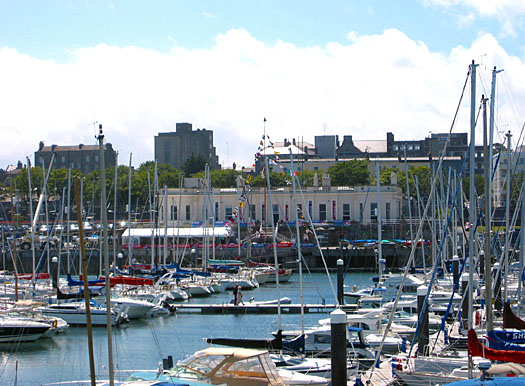
The Royal Irish YC's prime location and historic clubhouse within Dun Laoghaire Marina's sheltered water provides a perfect location for hosting major keelboat events. Photo: W M Nixon
The club in turn have brought in sponsorship for the ICRA Nats from Teng Tools, a company whose management have been long involved in offshore racing success, with Alan Crosbie of TT sailing in this event aboard the vintage Mills-designed Quarter Tonner Quest, a boat of contemporary relevance whose history includes association with such luminaries of Irish sailing as Marcus Hutchinson and Gordon Maguire.
Thanks to Dublin Bay's time-honoured tradition of enthusiastically racing boats which in most other sailing areas would be seen only as cruisers, the entry list includes the usual mix of modern performance craft from builders such as X Yachts of Denmark, J Boats of America, Elan of Slovenia, Beneteau and Jeanneau of France, and Hanse and Bavaria of Germany, and they'll be lining up with venerable cruisers such as the vintage Nich 31 Saki and others such as Soufriere for whom success is a bonus to be treasured in the simple pleasure of sailing a comfortable much-loved boat.

The Nich 31 Saki is regularly raced in Dublin Bay, and for the ICRA Nationals she'll be competing in Class 4 against the likes of First 211s and a Hunter Sonata. Photo: David O'Brien
For those who are looking for razor-sharp virtually boat-for-boat racing, Class 1 is surely the place to be, where the active fleet of Dublin Bay J/109s, rating around the 1.015 to 1.017 mark, find themselves head to head with last year's ICRA Nats star performer, Philip Byrne's XP 33 Bon Exemple from the host club, whose helming lineup includes current Irish Champion Ben Duncan.
However, inter-area rivalry is a great spur to success, and the pride of Fingal, Pat Kelly's J/109 Storm from Rush SC, has several years of ICRA success under her belt, including the Boat of the Year title. Another 'out of Bay' challenger in the J/109s is Ian Nagle's Jelly Baby from the Royal Cork, so it will be wall-to-wall J/109s in Division 1, a formidable prospect for one of the smallest boat in the class, Denis Hewitt and partners' Mills 30CR Raptor, whose personnel includes top ICRA mover and shaker Fintan Cairns.
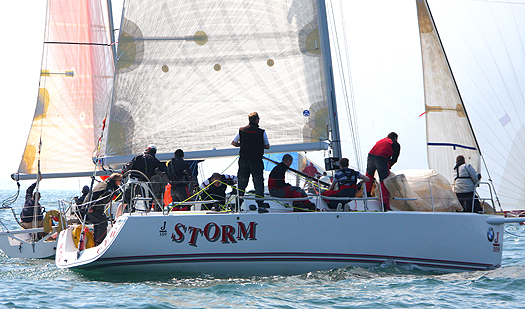
The J/109 has proven an ideal size for Dublin Bay and Irish Sea racing. Photo: David O'Brien
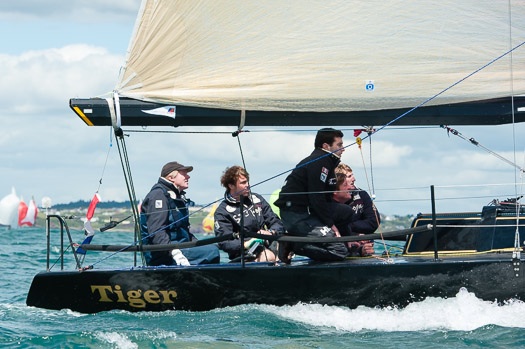
Father and son team of Neil and George Kenefick from Crosshaven will be campaigning their Quarter Tonner Tiger as Nathan Kirwan Trust during the ICRA Nats. Photo: Bob Bateman
The Dun Laoghaire emphasis in the fleet is an added peformance incentive for any visitors, and great things are expected in Division 3 from the Kenefick family's hot Quarter Tonner Tiger from Cork, which races this series as Nathan Kirwan Trust with former champion helm George Kenefick on the helm. Another visitor which has been making waves in the Irish Sea this year is the Shannon Estuary-based Dehler 34 Big Deal (Derek Dillon, Foynes YC), which has been scoring success in ISORA racing as part of the buildup to participation in the Round Ireland Race in three weeks time. The Dehler 34 has been around since 1980 or so, but this well-engineered cruiser-racer has deservedly proven an enduring success in Irish waters.
Further down the size scale, there's an impressive turnout of Corby 25s racing against Big Deal in Division 2 where winning will be an impressive notch in the bedpost as the lineup includes Anthony Gore-Grimes' regularly successful X 302 Dux from Howth, while Division 3 sees the continuing friendly (well, fairly friendly) war between vintage Quarter Tonners and J/24s such as Flor O'Driscoll's Hard on Port.

Anthony Gore-Grimes' X 302 Dux has been a regular and successful participant in ICRA events for many years. Photo: Bob Bateman
As for the Corinthians sailing non-spinnaker in Divisions 5 & 6, Eastsiders are pinning their hopes on the two extra-keen Howth boats. David Sargent's Elan 33 Indulgence, and the veteran Club Shamrock Demelza aboard which Windsor Laudan and Steffi Ennis have turned white-sail racing into an art, and a very successful one at that.

Transparency is all. George Sisk and his seasoned crew aboard the Farr 42 WOW will be racing with the second-highest rating in the fleet. Photo: W M Nixon
Up among the biggies in Division 0, Soufriere at 54ft is longest of all, and the highest rated at 1.135, but close astern is George Sisk's Farr 42 WOW, which rates 1.124. This provides a challenge for her senior crew, though we're assured that WOW doesn't stand for "We Ould Wans". Quite. There's a good outside challenge here with Denise Phelan's potent Mills 36 Jump Juice from Cork, the XP38i Roxstar (Findlay & Anderson) from the Clyde, the Corby 40 Converting Machine (Dave Cummaford) from Pwllheli, the pride of Arklow which is the Tyrell family's J/122 Aquelina, ICRA Commodore Nobby Reilly's Mills 36 Crazy Horse from Howth, and Lynx, Martin Breen's Reflex 38 which sails thousands of sea miles, many of them with racing success, for the honour of Galway Bay SC.
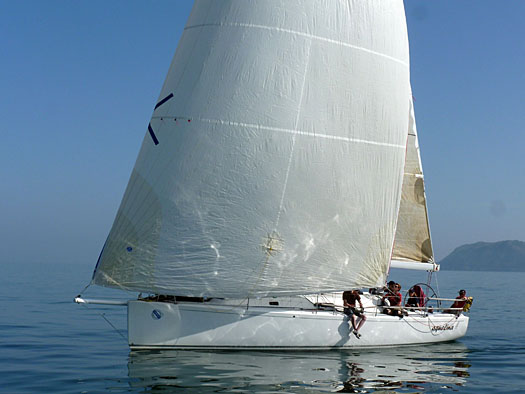
The Tyrrell family's J/122 Aquelina from Artklow is an active contender throughout the season. Photo: W M Nixon
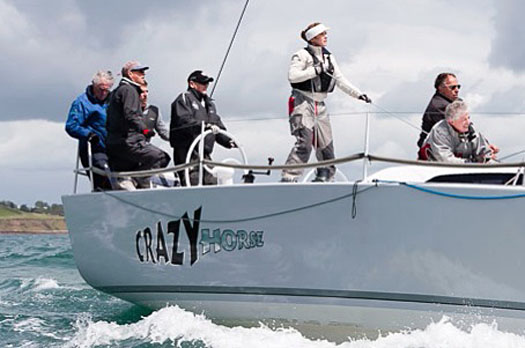
The main man. Nobby Reilly of Howth, Commodore of ICRA, at the helm of his Mills 36 Crazy Horse. Photo: Bob Bateman
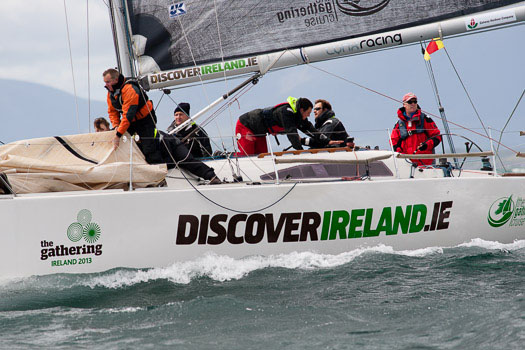
Martin Breen's Reflex 38 Lynx from Galway, seen here racing round Ireland, will be hoping to add ICRA success to her established offshore achievements.
Thus the lineup is what you'd expect of a sailing community emerging from several years of economic recession. There are few if any brand new boats, only a small group are travelling any significant distance to take part, and within the local fleet, as with the visitors, there's a marked emphasis on well-loved boats which have been with their owners for quite some time, but are continuing to give excellent value and great sport for the day that's in it.
And finally, if you don't believe a word about Soufriere being in a James Bond movie, here's the clip from Casino Royale. Soufriere was already being built when the request for her use in the film came through. But who could decline such a thing? It's even better than having a genuine Beken photograph of your boat.
Once upon a time, back in 1990, I sailed into Venice and motored right up the crowded Grand Canal as far as the Rialto Bridge with the late great Brian Hegarty on the Hallberg Rassy 42 ketch Safari of Howth. We'd a better time of it than poor old James Bond. We didn't have to waste time with the distraction of writing resignation letters on the laptop. For we were on our holliers, and believe me, arriving in Venice in the morning sunshine on a fine cruising yacht merits your full attention. It is one of life's great and magical experiences.
Meanwhile, back in Dublin Bay, first gun in ICRA Nats 2014 is at 1055hrs Friday June 13th, racing continues through Sunday May 15th, right hand side of the boat continues to be starboard, and the wind being on it usually confers right of way.
ICRA NATIONAL CHAMPIONSHIP 2014, 13th to 15th June 2014 ENTRIES (AS AT 6/6/14)
| Division | Sail No | Boat | Type of Boat | Club | IRC |
| 0 | IRL9852 | Crazy Horse | Mills 36 | HYC | 1.084 |
| 0 | IRL5718 | Loose Change | IMX 40 | RIYC | 1.073 |
| 0 | IRL1974 | Soufriere | Spirit | RIYC | 1.135 |
| 0 | IRL4208 | WOW | Farr 42 | RIYC | 1.124 |
| 0 | IRL1644 | Lively Lady | First 44.7 | RIYC | 1.107 |
| 0 | IRL2007 | Jump Juice | Ker 37 | RCYC | 1.103 |
| 0 | GBR6940R | Converting Machine | Corby 40 | Pwllheli SC | 1.095 |
| 0 | IRL1281 | Aquelina | J-122 | Arklow SC | 1.083 |
| 0 | GBR4041R | First Forty licks | First 40 | East Down YC | 1.080 |
| 0 | GBR8038R | Roxstar | XP 38i | Clyde CC | 1.077 |
| 0 | IRL4007 | Tsunami | First 40.7 | NYC | 1.055 |
| 0 | IRL7386 | Lynx | Reflex 38 | GBSC | 1.051 |
| - | |||||
| 1 | EI1906 | ZURI | Hanse 37 | Carlingford SC | #N/A |
| 1 | IRL3511 | Adventure | A35 | GSC | #N/A |
| 1 | IRL638 | State O’ Chassis | Sigma 38 | RIYC | #N/A |
| 1 | IRL3307 | Rockabill V | Corby 33 | RIYC | 1.041 |
| 1 | IRL3709 | Axiom | X 37 | RIYC | 1.035 |
| 1 | IRL3061 | Fools Gold | A35 | WHSC | 1.028 |
| 1 | IRL9609 | Jelly Baby | J109 | RCYC | 1.027 |
| 1 | IRL28898 | Powder Monkey | J109 | NYC | 1.025 |
| 1 | IRL7778 | Gringo | A 35 | NYC | 1.024 |
| 1 | IRL811 | Raptor | Mills 30CR | RIYC | 1.020 |
| 1 | IRL1141 | Storm | J109 | HYC/Rush SC | 1.017 |
| 1 | IRL8088 | Jedi | J109 | RIYC | 1.017 |
| 1 | IRL1206 | Joker II | J109 | RIYC | 1.017 |
| 1 | GBR8933R | Bon Exemple | XP 33 | RIYC | 1.016 |
| 1 | IRL1383 | Ruth | J109 | NYC | 1.015 |
| 1 | GBR9047R | Mojito | J109 | Pwllheli SC | 1.015 |
| 1 | IRL1129 | Jump The Gun | J109 | RIYC | 1.014 |
| 1 | IRL9898 | Indecision | J109 | RIYC | 1.013 |
| 1 | IRL29213 | Something Else | J109 | NYC | 1.013 |
| 1 | IRL7991 | Jigamaree | J109 | RIYC | 1.011 |
| 1 | GBR8609R | Jetstream | J109 | NYC | 1.009 |
| 1 | GBR2620L | Fox in Sox | X 34 | RIYC | 1.003 |
| 1 | IRL3471 | Black Velvet | First 34.7 | RIYC | 1.001 |
| 1 | IRL1367 | Boomerang | First 36.7 | RStGYC | 1.000 |
| 1 | IRL3470 | Flashback | First 34.7 | HYC | 0.989 |
| - | |||||
| 2 | IRL1310 | After You Too | Beneteau 31.7 | RStGYC | #N/A |
| 2 | IRL3438 | Albireo | Swan 371 | RIYC | #N/A |
| 2 | IRL7317 | Attitude | First 31.7 | RIYC | #N/A |
| 2 | GBR8747T | Movistar Bleu | Elan 333 | Killyleagh YC | 0.967 |
| 2 | IRL7284 | Red Rhum | Dehler DB1 | RStGYC | 0.967 |
| 2 | IRL8750 | Jester | J 80 | NYC | 0.957 |
| 2 | IRL1188 | Utopia | X 3/4 Ton | DL Marina | 0.956 |
| 2 | IRL8094 | King One | Half Tonner | HYC | 0.953 |
| 2 | IRL6909 | Extreme Reality | Beneteau 31.7 | RIYC | 0.952 |
| 2 | FRA079 | Graduate | J 80 | RIYC | 0.952 |
| 2 | IRL993 | Prima Nocte | Beneteau 31.7 | RIYC | 0.950 |
| 2 | IRL4170 | SLACK ALICE | GK Westerly 34 | WHSC | 0.949 |
| 2 | GBR66R | Checkmate XV | Humphreys Half Tonner | RStGYC | 0.943 |
| 2 | IRL5522 | The Big Picture | Mg30 | HYC | 0.942 |
| 2 | IRL8223 | Kamikaze | Sunfast 32 | RStGYC | 0.941 |
| 2 | IRL2552 | Fusion | Corby 25 | HYC | 0.935 |
| 2 | IRL2506 | Alpaca3 | Corby 25 | RCYC | 0.931 |
| 2 | IRL2507 | Impetuous | Corby 25 | HYC | 0.930 |
| 2 | IRL3492 | Big Deal | Dehler 34 | Foynes YC | 0.929 |
| 2 | IRL2525 | Tribal | Corby 25 | GBSC | 0.929 |
| 2 | IRL25007 | Smile | Corby 25 | GBSC | 0.929 |
| 2 | IRL988 | DUX | X-302 | HYC | 0.929 |
| 2 | IRL7495 | Maximus | X-302 | HYC/WHSC | 0.925 |
| 2 | IRL521 | Bendemeer | Beneteau First 325 | RStGYC | 0.925 |
| 2 | IRL1103 | Solgari Viking | X-302 | HYC | 0.923 |
| - | |||||
| 3 | GBR8148 | Squawk | Sigma 33 ood | BYC/RUYC | #N/A |
| 3 | I8709 | Cri-Cri | Quarter Tonner | RIYC | #N/A |
| 3 | ITA10767 | Don Giovanni | Ceccarelli | HYC | #N/A |
| 3 | IRL9311 | Borraine | Aphrodite 101 | RIYC | #N/A |
| 3 | IRL4384 | Django | J24 | Lough Ree YC | #N/A |
| 3 | IRL5795 | Black Sheep | Mustang 30 | NYC | 0.919 |
| 3 | GBR5507T | Peridot | Mustang 30 | RIYC | 0.916 |
| 3 | IRL4464 | Springer | Sigma 33 ood | RStGYC | 0.912 |
| 3 | IRL4536 | Elandra | Sigma 33 | DL Marina | 0.912 |
| 3 | IRL4633 | White Mischief | Sigma 33 ood | RIYC | 0.911 |
| 3 | IRL34218 | Lady Rowena | Sadler 34 | RStGYC | 0.911 |
| 3 | IRL999999 | Nathan Kirwan Trust | 1/4 ton | RCYC | 0.907 |
| 3 | IRL508 | Quest | 1/4 ton | RIYC | 0.905 |
| 3 | FRA9186 | Cartoon | Quarter Tonner | RIYC | 0.902 |
| 3 | IRL8188 | Alliance II | Laser 28 | HYC | 0.896 |
| 3 | IRL4533 | Crazy Horse | J24 | Sligo SC | 0.887 |
| 3 | IRL680 | Euro Car Parks Kilcullen | J24 | HYC | 0.887 |
| 3 | IRL4794 | Hard on Port | J24 | RStGYC | 0.887 |
| 3 | IRL9508 | Huggy Bear | Impala 28ood | NYC | 0.884 |
| 3 | IRL728 | Maximus | J24 | Foynes YC | 0.884 |
| 3 | IRL851 | Taiscealai | Club Shamrock | RIYC | 0.876 |
| 3 | IRL7500 | Supernova | Quarter Tonner | RIYC | 0.870 |
| - | |||||
| 4 | IRL1208 | Capilano | Beneteau First 211 | RIYC | #N/A |
| 4 | IRL2121 | Chinook | Beneteau First 211 | RIYC | #N/A |
| 4 | IRL2111 | Syzrgy | Beneteau First 211 | RStGYC | #N/A |
| 4 | 307 | Wynward | Beneteau First | RIYC | #N/A |
| 4 | IRL246 | Saki | Nicholson 31 | RIYC | #N/A |
| 4 | IRL6556 | Challenger | Challenger Europe | HYC | #N/A |
| 4 | IRL1689 | Chouskikou | First 28 | DL Marina | 0.870 |
| 4 | 8245N | Asterix | Hunter Sonata | DL Marina | 0.823 |
| - | |||||
| Non-spinnaker Corinthian Cup | |||||
| 5 | IRL37747 | Windshift | Sunfast 37 | RStGYC | #N/A |
| 5 | IRL607 | Effex II | First 35 | RIYC | #N/A |
| 5 | IRL532 | Orna | Grand Soleil 40 | NYC | 1.021 |
| 5 | IRL3506 | Just Jasmin | Bavaria Match 35 | RIYC/DMYC | 0.995 |
| 5 | IRL8478 | Warrior | Beneteau 34.7 | ISA-DBSC | 0.984 |
| 5 | IRL1357 | Humdinger | Sunfast 37 | Carlingford SC | 0.972 |
| 5 | IRL3339 | Indulgence | Elan 333 | HYC | 0.958 |
| 5 | IRL1333 | White Lotus | Elan 333 | DL Marina | 0.957 |
| 5 | IRL3400 | Brazen Hussy | Dufour 34 | HYC | 0.950 |
| 5 | IRL5687 | To Infinity and Beyond | Dehler 37 CR | RStGYC | 0.949 |
| - | |||||
| 6 | IRL1217 | The Great Escape | Bavaria 33 | RIYC | #N/A |
| 6 | IRL1309 | Syledis in blue | Beneteau oceanis clipper 323 LK | Bray SC | #N/A |
| 6 | IRL5013 | Sweet Martini | She 31 | RStGYC | #N/A |
| 6 | IRL966 | More Mischief | Beneteau First 310 | DL Marina | #N/A |
| 6 | IRL2860 | Pure Magic | Feeling 286 Special | Bray SC | #N/A |
| 6 | IRL1166 | Edenpark | Jeanneau Sun Odyssey | RIYC | 0.977 |
| 6 | IRL5643 | Calypso | Beneteau Oceanis 361 | RStGYC | 0.928 |
| 6 | IRL1502 | Vespucci | Dehler 31 | RIYC | 0.876 |
| 6 | IRL100 | Demelza | Club Shamrock | HYC | 0.875 |
A PDF version of this entry list (with owners names) is available to download below
#historicboats – The historic Water Wag class in Dun Laoghaire have been doing well for some time now, but for 2014 they're already showing even more vitality. W M Nixon reckons they're right up there with the famous X One Designs in the Solent.
Ireland is a small and not very affluent piece of land, surrounded by a lot of water. The Solent is a small piece of water, surrounded by a lot of very affluent land. If you're looking for somewhere very different for your holiday weekend's sailing, it's right there, down south between Hampshire and the Isle of Wight
With the first proper summer Bank Holiday upon us today after a long recession-mired winter, you could be forgiven for thinking about where best to go for a change of scene and mood. Possibly, you're seeking somewhere which is as different as possible from the wide open waters of Ireland, yet provides the kind of sailing to which we can relate.
The Solent is home to very special local class which, when you sail in it, proves to have all the flavour of a good Irish local class, but with the extra ingredient of being a focus of attention in a prosperous area which happens to be one of the global centres of the international marine industry.
The 21ft X One Design is the very essence of Solent sailing, a distinctive presence along that unique waterway, whose name is a matter of conjecture. For me, the word "Solent" has always simply suggested the opposite of "Insolent", as it has the reputation of providing gentle unsurly waters and a choice of snug harbours when things might be rougher outside in the English Channel.
Maybe so, but I can well remember being on passage down Channel from Kent towards Ireland a long time ago with a new trimaran which was proving a tricky proposition. We dodged north of the Isle of Wight for the fun of it, and soon discovered some inherent structural faults in the boat which became startlingly evident in the drubbing provided by strong ebb against the wind in the Western Solent.

The first X One Designs in 1911 were built as a trainer class for the Royal Motor Yacht Club, and carried a very conservative rig. Photo courtesy XOD Assoc.
Be that as it may, the Solent provides a wonderful variety of sailing in its relatively small area, and it suits the X One Design so well that you'll find its local fleets have spread west and east, the most westerly being at Parkstone on Poole Harbour, while the most easterly is Itchenor on Chichester Harbour. In a spirit of fierce local pride the sailors in Poole and at Itchenor will assure you they aren't in the Solent at all, but they've ready access to it, and the great festival of the class is Cowes Week, where the six local fleets assemble annually, mustering an extraordinary 145 boat for the X One Design Centenary in 2011.
Their history may be long, but they're not burdened by it, for the world has older keelboat classes which feel more obliged to adhere strictly to their own original rules, designs and specification. By contrast, the origins of the XOD are very low key. Back in the height of the Edwardian era, the Royal Motor Yacht Club, with a headquarters ship in Southampton Water, reckoned that it would be a good idea if its younger members had the opportunity to learn to sail. As well, with their senior members swanning about in large power yachts seen as elitist, it was probably reckoned it would do the image of the club no harm to have a fleet of boats which could provide sailing for local school children and students. So they commissioned a flotilla of 21ft keelboats from Alfred Westmacott, a noted designer of small keelboats, then had them rigged as simply as possible as gaff sloops with a club boom on the jib. On June 3rd 1911, their first race was sailed.
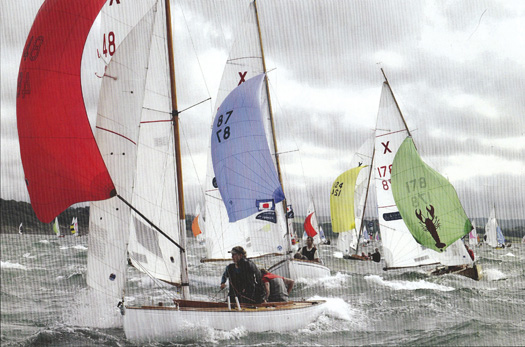
X One Designs doing what they do best, churning up the West Solent at Cowes Week over a weather-going ebb tide. Photo: Rick Tomlinson
As with everything in those days, the Great War of 1914-18 brought sailing to a halt. But by the 1920s, other clubs in the Solent area were cottoning on to the XOD's good all round qualities, which became more widely known when the Royal Motor YC moved itself to new premises at Parkstone on Poole Harbour. The growing class acquired its first Bermudan rig in 1928, with a notably large mainsail. This was mercifully reduced by shortening the boom in 1951, thus enabling a standing backstay to be carried, and today the rig is well able to provide crisp performance.
By the 1950s the class was taking off, regularly bringing the largest fleet to Cowes Week. But local racing was very strong too. Lymington had provided fertile ground for expansion, and the town's half day being a Wednesday (hands up anyone who remembers when shops used to close for one entire afternoon at lunchtime mid-week), that's when the XODs had their keenest racing. Back in the day, if you happened to be doing business with a yacht design or marine engineering office in Lymington, it was a waste of time trying to contact anyone there on a Wednesday afternoon - they were all out racing their XODs.
Though the hull has remained strictly as designed by Westmacott, and though traditional wood construction of carvel planking on bent frames still prevails despite attempts to introduce edge-glued strip planking or even GRP, with so many world class talents getting involved in XOD racing, the layout of the cockpit, and the tuning of the very simple-looking rig, have been refined to a very high level.
The result is excellent ergonomics in the cockpit layout. Unlike some keelboats in which only the helmsman has an athwartships seat, the XOD has decently comfortable fore-and-aft benches either side, and at 21ft she's just big enough to accommodate them without the side decks being made dangerously narrow. The mainsheet and several other controls are led to a pillar at mid-cockpit, while further control on the main is provided by the full length track across the after deck with the carriage adjusted by a single line which goes from the carriage through a mini hawsehole in the deck at centre-line, and forward underneath everything to come up to a jammer on the aft side of the pillar.
As for the mainsheet itself, this is continuous, going through a double jammer very easily accessed on top of the pillar. The result to a tyro XOD sailor like me seems to be that if you haul on something – anything - which is clearly the sheet, the main comes in, and if you let it out, out she goes with never a bother.
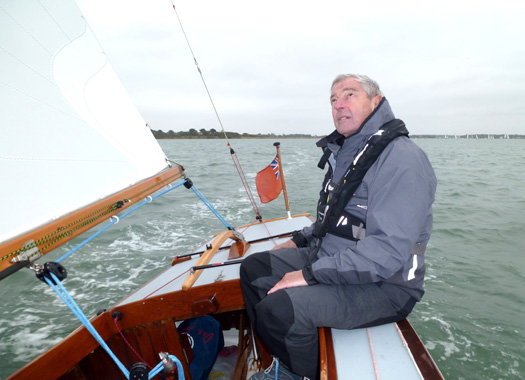
Ted Roose at the helm of his beloved 1953-built XOD Thora, heading down to the start with the ensign flying to indicate the boat is not yet racing. Photo: W M Nixon

This is the bit that really does the business. The vital pillar carries the easily-handled mainsheet and other controls. The line on the forward side is the hauler for raking the mast forward. Photo: W M Nixon
But then, maybe I was lucky with my skipper, Ted Roose of Itchenor Sailing Club, who provided me with my maiden XOD race last September aboard his XOD Thora, no 101 built 1953, as it was great sport throughout. But Ted being one of those quietly determined skippers who is usually in the frame, his competence in handling his boat in some lovely close quarters competition probably made it all seem much easier than it really was. And as the race progressed on an unseasonal grey Saturday afternoon, but with a decent little breeze, I was lost in admiration for a deceptively simple yet very effective cockpit layout which added greatly to the pleasure of sailing.
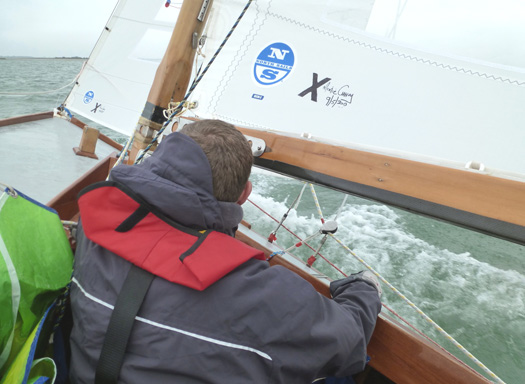
There's no need to clamber out of the X One Design's cockpit when setting the spinnaker, as the forward crewman is sitting on the "mezzanine thwart" which gives him enough height when standing to do the job quickly and easily. Photo: W M Nixon
For instance, at the forward end of the cockpit, some genius many years ago introduced a "mezzanine thwart". This means that the forward or third hand, the spinnaker person, has somewhere useful to sit where they are much more comfortable than merely crouching. They also have a useful line of sight under the jib, they keep down low out of the helmsman's line of vision, and then when they come to set the spinnaker, lo and behold they have the height to do it easily by standing on the thwart, which has a non-slip surface, with no need to go on the foredeck at all.
And when you've the spinnaker up on a dead run, the skipper quietly requests the mid boat man to give a mighty heave on a line which runs up the forward side of the pillar. The foot of the mast then comes aft on a slider for what looks like all of five inches, and downwind performance is improved by having the rig then hanging – actually drooping, some might say - over the bow.

When the X One Designs put rake in their mast, they don't mess about......running position left, beating position right. Photo: W M Nixon
The race offered an ideal opportunity to see the Itchenor class in action, as Ted had very obligingly agreed to go out for just the middle race of a three race weekend series which was nicely designed in civilized style with two races on the Saturday, then one on Sunday morning with a very relaxed lunchtime prize-giving in the clubhouse afterwards.
Fortunately the one race we did had far and away the best breeze of the weekend. Thus we didn't feel too bad about depriving Ted of his full quota of sport, but one race was the limit, as the foredeck hand and his father the visiting crewman were obliged to be present at the Christening of one Magnus at the Parish Church in Bosham next morning. That was something which in turn seemed part of a bigger picture, as the church in Bosham was frequented by King Canute, one of the more civilized Vikings rulers of England, while young Magnus takes his name from St Magnus the Martyr, who persuaded his fellow Vikings to ease off on the violence, but thereby lost his head in becoming the first and last Viking saint.

Chasing up the opposition – the easily controlled X One Design gives splendid close quarters racing. Photo: W M Nixon

Once the crew in the other boat start looking astern all the time, you know you're closing in for the kill. Photo: W M Nixon
Such things were far from our mind as we sailed a busy little race, made even busier by the assumption that in this three class series, the XODs would as usual be starting five minutes after the Sunbeams which in turn would be five minutes after the Swallows. But some cunning devil had decided that the start order should be Swallows, then XODs, and then the Sunbeams. It definitely wasn't Thora's best-ever start, but with a mountain to climb, Ted was in his element. He was brilliant. With fifteen boats racing, and just about all of them ahead at the start, we nevertheless got up to fourth at one stage, and though we were either sixth or seventh at the finish, it had been a marvellous afternoon's close quarter sport in which we'd experienced local racing at its very best.
The keen local level of Itchenor racing transferred to Cowes Week very well in 2013. And our header photo shows why the XODs revel in racing at Cowes. They're just the right size to make the Solent interesting and sometimes quite a challenge. And it's a special pleasure to use that particular photo, as it was taken by James Tomlinson aged 14, son of ace maritime snapper Rick Tomlinson. The apple seldom falls far from the tree.

John Tremlett, overall winner of the X One Design Class at Cowes Week 2013. Photo: W M Nixon
Leading the charge for Itchenor at Cowes was John Tremlett sailing Jeremy Lear's 1946-built Lass, who won overall in a fleet of 79 boats. For the Centenary in 2011 they had tried some Committee Boat starts to accommodate the 145 boat fleet, but the essence of racing XODs at Cowes continues to be the fixed start on the line from the Squadron Castle. We were yarning after the racing in Itchenor, and I asked the prime question: How on earth anyone come winning out of a start situation like that?
Simple really, said big John. You know there is one perfect spot right in under the castle from which to make your start. The secret is to get as near to that spot as possible while still keeping your wind clear and keeping the boat with good way on. You absolutely must keep a clear wind. So easy, don't y'know.....?

The classic X One Design start on the Squadron line at Cowes. No 123, Lara built by Burnes of Bosham in 1960, has either got it spot on, or they're in for a 7% penalty.
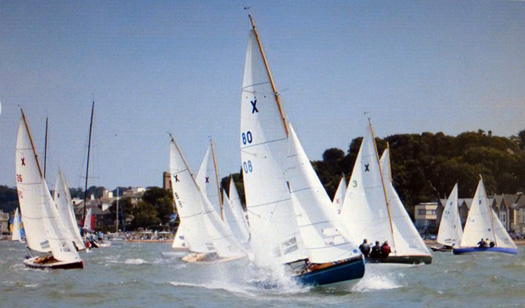
The 1946-built Lass (no 80), helmed for Jeremy Lear by John Tremlett, has emerged from a start in Cowes Week 2013 in a very strong position, with the fleet nicely under control.
Inevitably, when you've savoured something as good as XOD racing with on of the hotter fleets, you try to find comparisons in Irish sailing. Back in the 1950s it was surely the Dublin Bay Mermaids, which had fleets along the East Coast all the way from Wexford to Skerries, and had the turnouts nudging the 90 mark for their annual Mermaid Week.
But this year is the first in which Mermaids don't figure in the Dublin Bay programme. They just became too thinly spread, whereas the XODs are quite the opposite. They are the Number One local class on what is in effect a salt water lake, with their boats built both on the island and on the Hampshire shore, and they're within ready reach of an extensive and very affluent part of England.
So where in Ireland do we have a salt water lake in the midst of a large and affluent population? Dun Laoghaire, that's where. In its way, the harbour at Dun Laoghaire, rather than Dublin Bay itself, is the Solent of South Dublin. And if we accept that this is the case, then obviously the equivalent of the XODs in Dun Laoghaire Harbour will have to be a smaller boat, and a local class with a bit of history to it as well.
Step forward the Water Wags. They're currently on a roll with turnouts which are modern records for the class. A new boat – number 45 – is being built by Jimmy Furey of Lough Ree for and with Cathy MacAleavey. And among the boats already in existence, there's a strong sense of community allied to a lively spirit of competition.
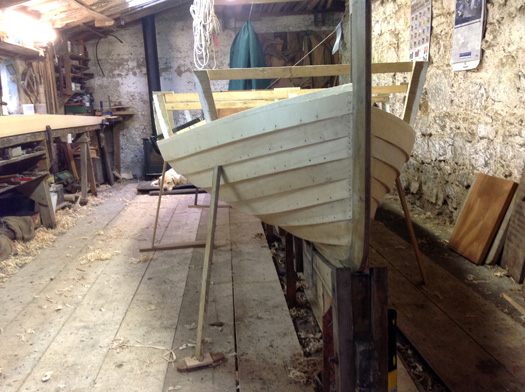
The beauty of traditional clinker construction. Water Wag no 45 is currently being built by Jimmy Furey near the shores of Lough Ree. Photo: Cathy MacAleavey
There's history too, of course, and it's even more interesting than the XODs. Or indeed any other One Design class, for the Water wags were the first One Design Class of all in 1887, using a pretty little double-ended 12ft dinghy series-built in Scotland.

The "new" Water Wags in action in Dun Laoghaire Harbour for the regular Wednesday evening race . The current design was introduced in 1902-03 to replace the original smaller Water Wag from 1887. Photo: Cathy MacAleavey
But then, as other newer and bigger classes began to poach their sailors during the hyper-growth of Dublin Bay Sailing Club around 1900, the Water Wags took a radical step which some other classes could usefully emulate. They got James Doyle the local boat builder to design them a much more able 14ft gunter sloop-rigged dinghy, and changed en masse in 1902-03, changing their game in a way some other classes might like to do, but have never managed.

The Doyle design team, father and daughter or maybe just daughter alone, successfully fulfilled the brief for a new larger Water Wag very well, and today they race more enthusiastically than ever in their "salt water lake" of Dun Laoghaire Harbour. Photo: Cathy MacAleavey
The creation of the new boat brought its own stories. James Doyle's daughter Maimie was at the very least a talented draughtswoman who put manners on her father's rough sketches to turn them into finished designs. But some would argue that she actually designed the new Water Wags. Certainly some time later the Doyle-created designs of a projected cruising yacht called Granuaille appeared in one of the sailing magazines, and the write-up clearly hinted that it was entirely Maimie's own work. This got her poor father so much stick that a subsequent issue of the magazine was obliged to list all the boat designs he – and he alone – had created.
Maimie Doyle's boat design achievements between 1890 and the outbreak of war in 1914 become all the more remarkable when we consider that there have been very few women naval architects in the hundred years since. But who knows, now that Cathy MacAleavey is again working along with Jimmy Furey on a boat-building project (they've already created a lovely Shannon One Design), perhaps she might turn her hand to the design side too.
Meanwhile the Maimie Doyle-designed Water Wags have become a sociological phenomenon in Dun Laoghaire. In times long past, they would appear at regattas elsewhere, but these days they seldom go out of the harbour, as it provides an ideal sailing stadium, though they're so manageable that every so often there's a trailer-borne class excursion to one of Ireland's great lakes.
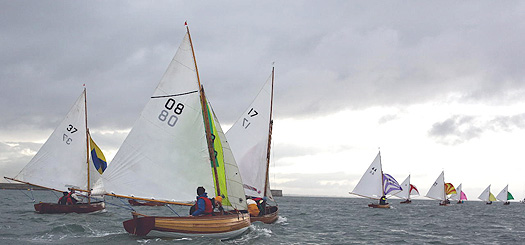
The clouds are lifting. Today's Water Wags hasten towards a bright horizon. Photo: Cathy MacAleavey
Jimmy Furey's boat-building is a work of art. Detail at the centre-plate slot of the new No 45, where the steamed frames will be bent to fit neatly in the larger gaps between the fastenings. Photo: Cathy MacAleavey
Manageability and community. That really is the essence of the Water Wags' new wave of vitality. Nevertheless, there'll always be people in Ireland who will only feel comfortable with a keel under them, people who seek an ergonomically-sound little keelboat with a surprisingly good performance. And one of minimal maintenance too. The Water Wags may be able to find handy sheds for their hibernation and off-season maintenance, but our climate is cruel for little wooden keelboats, so we need a good little glassfibre semi-traditional keelboat bigger than a Squib or a Flying Fifteen.
But why reinvent the wheel? It's just possible that somewhere around Lymington there's one of the glassfibre XODs which were reputedly built as an experimental project, but like the glassfibre Mermaids, were rejected by traditionalists. A glassfibre XOD might just suit Irish conditions very well indeed.

Action at the weather mark. With their intensive racing within Dun Laoghhaire Harbour, the reinvigorated Water Wags are a sociological and sporting phenomenon, and their regular Wednesday evening race is a highlight of the harbour's weekly progamme. Photo: Cathy MacAleavey
#dlharbour – Gerry Dunne, Chief Executive of Dún Laoghaire Harbour Company responds to WM Nixon's article Has Dún Laoghaire Lost the Plot?
Mr. Nixon and the Harbour Company share one thing in common – a passion for Dún Laoghaire Harbour. It is a unique amenity for the people of Dún Laoghaire, for the City and County of Dublin and for the nation. Since its construction almost 200 years ago, it has served and continues to serve an evolving community of interests. First came the ferry boats and freighters, followed by the railway. Then came the sailors and the yacht clubs. Various businesses have come and gone. And at all times, the people have come.
Sustainable development
We in the Harbour Company have a vision for the sustainable development of Dún Laoghaire Harbour in conjunction with the revitalisation of the town. We have been working assiduously towards this objective. Minister Varadkar's Port Strategy of March 2013 puts it lucidly when it states that the long term future of the Harbour will be in terms of marine leisure, maritime tourism, cultural amenity and urban redevelopment.
It is against this backdrop that I address two points raised by W.M. Nixon regarding Masterplan proposals:
- the urban beach
- the new cruise berth.
Mr. Nixon's concerns regarding the urban beach are twofold – disruption during the construction phase and effect on access when constructed. On these issues, expert advice available to the Harbour Company indicates that there is likely to be very little disruption during construction. As for access, since this project was first proposed in the Masterplan, the design of the urban beach has been expressly modified in order to ensure there will be no access issues for members of the National Yacht Club and, most importantly, the RNLI.
Beating heart
The sailing community is, and will always remain, a key stakeholder in Dún Laoghaire Harbour. Sailing is the beating heart of Dún Laoghaire Harbour. As Mr Nixon knows, the Harbour Company works closely with the yacht clubs to attract major international sailing events to the harbour. It would frustrate our objectives if any of the proposed Masterplan developments were to make the harbour a less attractive location for sailing and sailors. In fact, a working group has been convened with the sailing community and the Harbour Company with the overall strategic objective of attracting major international sailing events and associated festivals to Dún Laoghaire.
This season (2014), swing moorings in the west Bight were eliminated and the swing moorings in the East Bight were reduced by 40% . This initiative was referenced in the Harbour Masterplan and implemented with the co-operation of the yacht clubs, with the objective of creating a substantial quantum of waterspace in the safe environment of the harbour for youth training and in-harbour sailing.
When preparing this article, I took time to read the newspaper reports from the 1990s about the then proposed marina and the many objections that were raised to its construction. One of the points raised in the the objections to the marina was the encroachment on in-harbour sailing and training and possible safety issues. Mention of the marina is instructive as it illustrates that a development that might originally have been viewed sceptically by some can turn out to be something that becomes much-loved and emblematic of the harbour.
The cruise business is a growing market sector in the tourism industry. Ireland has recently begun to capitalise on this market and has succeeded in attracting a growing number of visits by cruise liners. Dún Laoghaire has been important to attracting these cruise calls, and in 2015, over 100,000 passengers/crew will visit the town as part of their cruise tour. Interestingly, the number of cruise calls to Ireland represents a relatively small share of this potential market, and there is a clear opportunity to grow this business very significantly for the benefit of the Irish economy. The harbour offers stunning views of Dublin Bay, Killiney Hill, the town itself and, in the distance, the Dublin and Wicklow Mountains.
Many commentators agree that this location offers a far more attractive destination for cruise passengers than the industrial environment of Dublin Port.
Mr. Nixon questioned the economic benefit to the town of the leisure cruise business. Importantly, businesses in the town are enthusiastic supporters of this initiative, through the Dún Laoghaire Cruise Stakeholder Group. A detailed report, conducted by independent economic consultants in 2011, estimated that a new cruise facility would bring significant benefit to the area, with over 30% of the economic value of the cruise visits impacting directly on Dún Laoghaire.
The Dún Laoghaire Harbour Masterplan was adopted in October 2011 following an extensive consultation process with the public and key stakeholders. The Masterplan sets out a long-term vision for Dún Laoghaire Harbour. It seeks to realise the potential of the Harbour as a major marine, leisure, cultural and tourism destination, as well as securing its long-term economic viability. It does this in line with the Government's ports policy.It is in the implementation of this policy that Dún Laoghaire Harbour can be developed and reach its full potential as a leisure port facility. We have a wonderful asset, an unparalleled asset, an asset with a unique history. It is the opinion of many that it truly is one of the most beautiful man-made harbour in the world. It offers a striking blend of modern amenities, mixed with a traditional marine ambience.
One can be nostalgic for the time when the town with its harbour "was known as Kingstown and had its origins in the heights of gentility and middle class refinement". However, while seeking to preserve the unique character of the harbour that has made it such an attractive place to visit or in which to sail, Dún Laoghaire Harbour must adapt to survive. Sailing may be the beating heart of the harbour, but a heart does not beat by itself. There must be due regard for the needs of all harbour users including the general public. A core objective of the Masterplan is to increase public access to the waterfront.
Economic realities
There is a significant annual cost to the maintenance and development of a wonderful asset such as Dún Laoghaire Harbour. The stakeholders and the general public expect to see a harbour full of vitality, in pristine condition, with first class facilities and properly maintained. Dún Laoghaire Harbour Company works constantly to seek to meet these aspirations. What might not be well known is that the yacht clubs make only a very nominal contribution to the cost of continuous maintenance and repair work for this almost-200 year old man-made facility. As the Government has made it clear that it will provide no funds for maintenance or development of the harbour, the Company must rely on commercial opportunities to provide the resources necessary to ensure that the harbour meets the expectations of all users. Without commercial income, such as income from cruise calls, we would simply not be in a position to maintain the high standards which all harbour users have come to expect.
Cultural significance
Apart from the development of the proposed cruise facility and the urban beach, the Harbour Masterplan has identified other exciting plans, including the delivery of an International Diaspora Centre. The plans for this Centre take account of the historical significance of the harbour over almost two centuries in the movement of millions of migrants between Britain and Ireland. The proposed Centre will offer visitors from at home and abroad a world-class visitor experience and will have the potential to put Dún Laoghaire on the global map as a top visitor destination.
The Directors and staff of the Harbour Company take our role as custodians of the harbour very seriously. Our first responsibility is to make sure that the harbour is well run and economically viable. Our commitment must be to all those who use the harbour – sailors, yacht club members, anglers, ferry passengers, cruise passengers, tourists, local residents, occasional visitors, regular walkers and, not least, the general public.
The coming months and years represent a hugely exciting opportunity for the Harbour, and for the town of Dún Laoghaire. In embracing this opportunity, the Harbour Company will always remain cognisant of the history, heritage and potential of this wonderful place.
#woodenboat – The wonderful world of Ireland's wooden boats is a winding trail. W M Nixon went to West Clare to see one boat, but unexpectedly happened upon another with which he was totally smitten. Then he found the original objective of his travels was even better than expected. And finally back home, he found the project to re-create Asgard's 10ft dinghy from 1905 has produced a gem of classic boat-building.
With Sally O'Keeffe, it's love at first sight. I defy anyone to resist the allure of this shapely beauty.
You may have heard of this community project in southwest Clare, to build a replica of the working cutters which used to ply their trade in the demanding waters of the Shannon Estuary. And like me, you may even have noted with pleasure that the designer to the project was Myles Stapleton of Malahide, the great unsung star of Irish naval architecture, who has never drawn an unharmonious line in his life.
Yet like me, while you may have been aware that the boat was first launched in 2012, somehow neither of us has ever been in the presence of this remarkable little ship. And this despite the fact that she has been cutting a swathe through the fleet at classic and traditional events between Galway Bay and Baltimore for the past year and more.
Even with all this, I was actually trying to find the whereabouts of another new wooden boat entirely when I stumbled upon Sally O'Keeffe - newly-launched in Kilrush last Saturday - and was instantly smitten. For she's only gorgeous. She looks so utterly right, she's mad keen to sail which she does very well indeed, and she brings much pleasure to everyone involved. This has to be the community project par excellence. But then, Querrin in West Clare is a genuine community par excellence, an idea and vision as much as a place.
It's spread out on your left down towards the Shannon Estuary as you enter the Loop Peninsula, which is Ireland's ultimate place apart. Loop Head's island atmosphere is very marked, with the extensive but shallow Poulnasherry Bay west of Kilrush pushing northwest deep into the land, almost to Kilkee. Thus places like Querrin, until well into the 19th Century and even later, were much reliant on goods being landed at and exported from their little quays.
The Shannon Estuary is a mighty highway, but with the biggest tides in Ireland – 5.6 metres range at top of springs – the workboats carrying the vital goods had to be multi-functional and capable of taking aboard diverse cargoes. Not least of the requirements was a good all-round sailing ability, for although the Galway Hookers away to the north largely plied their trade by reaching back and forth across Galway Bay from Connemara to the Aran Islands, the Shannon Hookers had to excel in windward ability in order to sneak along inside the inevitable foul tides, and weather the increasingly difficult headlands which they encountered as they made their way west. Thus the boats which regularly sailed to Querrin were among the most able on the estuary, and long after the last of them sailed, the folk memory of their significance lingers on.
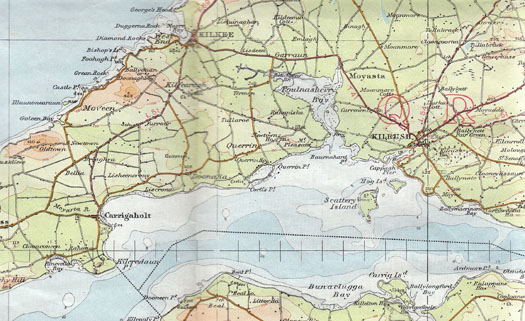
Querrin at the heart of things. Once you get west of Poulnasherry Bay, you're in the remote island-like atmosphere of the Loop Head Peninsula. Loop Head itself is another six miles west of the left edge of this map

Sally O'Keeffe provided a formidable design challenge for Myles Stapleton, as he had to create a roomy and high freeboard hull which still managed to incorporate elegant curves, yet all within an overall hull length of only 25ft. And of course, she had to sail very well too. Photo: W M Nixon
It was thought that the ribs of one of the old sailing workboats were sticking out of the mud at Blackwater Bridge on the road approaching Querrin from Moyasta. So as a local Querrin Sailing group began to gain traction, they got the notion of getting those last remains out of the mud, and restoring a proper Shannon Hooker to be the flagship of their little fleet, and the focus of a worthwhile community project in boat-building.
Perhaps it's as well the old wreck proved to be no more than shallow-water cot, for this seeming disappointment led eventually to designer Myles Stapleton and a magnificent but manageable project to build a new 25ft Shannon Hooker, using ancient photos and old drawings to re-create the best of the type.
In Querrin, Ned Griffin lent his fine shed up the hill for building the new boat, and as she took shape he also came up with the perfect name. In the 19th Century, Sally O'Keeffe had been the wife of a Querrin-based sailing workboat skipper, and she was a woman still remembered. It's a name of great style, but lest anyone think it's just too good to be true, let it be known that in 2012 as the new boat was making her debut, didn't Sally O'Keeffe's grandson – aged a hundred – return from America to give his blessing?
The building had started in 1910, and this Seol Sionna project drew on many sources and much voluntary labour, both within southwest Clare and further afield, to reach completion. They had the benefit of the extensive knowledge of traditional craftwork guru Cristoir Mac Carthaigh, who may be best known for his work in traditional boats, but if you've a bit of old-style thatching in mind, he can help you there too.
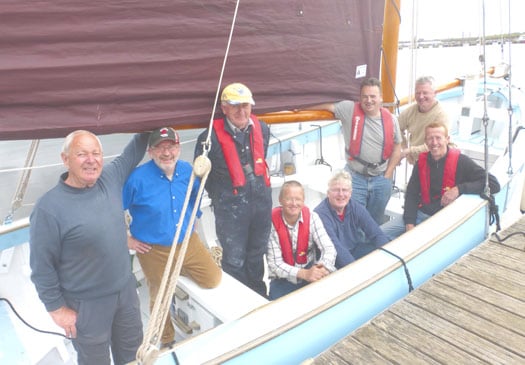
Some of the team at Querrin Sailing who built and sail the Sally O'Keeffe. Seen aboard on launching day at Kilrush are (left to right) Joe Hassett, Criostoir Mac Carthaigh, Michael O'Connell, Stephen Morris, Dixie Collins, Fintan Ryan, John Kennedy and Stephen Courage. Photo: W M Nixon

Steve Morris. Photo: W M Nixon
As for the building team, the trainee boatbuilders ranged in age from 16 to 80. It all became very possible thanks to Steve Morris, a fully-qualified New Zealand boatbuilder who came to Ireland a long time ago while taking a world backpack tour, and somehow stayed. He got involved in the building of the Jeannie Johnston on Tralee Bay in 1986, and for several years now he has lived near the shores of Poulnasherry Bay, and is a pillar of the maritime scene locally and nationally.
Steve served a full five year apprenticeship in boat-building in Auckland, so the community boat-builders of Querrin have had guidance and teaching of gold standard. In fact, thanks to Steve's input and the enormous goodwill and enthusiasm which the project engendered, it's doubtful if she could have been better built anywhere else in Ireland, while this video of him demonstrating caulking skills shows the standards to which they worked.
The ethos underlying the project has been eloquently articulated by Richard "Dixie" Collins, another of the key movers and shakers in Querrin Sailing:
"This is very much a community project from Loop Head peninsula. A keen, salty group who are sharing skills and enthusiasm for getting out on the ocean, to a place with a big sky and lots going on. There is training in seafaring skills for people who have never been out in a boat, and we provide trips to islands, and old piers which were built for boats like this in another time.
Our logo is taken from a gravestone in Scattery Island church of a boat-builder by the name of O'Mahony in 1832. In this small rural part of the western seaboard, we have built a sailing boat which we can maintain ourselves, and we offer sailing opportunities for everyone in the area for a five euro contribution to the club. An important outcome is the capacity building with new relationships, generational sharing of learning and having a right good time ourselves. It strengthens our sense of community, and is a shared credit to the collective efforts of everyone."
Despite the robust hull's obvious sailing power, Sally O'Keeffe needs only one hand on the tiller.
As the Sally O'Keeffe was going to be kept undecked with her hull limited to 25ft overall, for safety reasons they had to ask Myles Stapleton to give her quite high freeboard. It says everything about his skills as a creator of good-looking boats that despite the high freeboard – which has proven a Godsend in both the Estuary and on some remarkable and swift coastal passages on the open Atlantic north to Galway and south to Baltimore – the Sally O'Keeffe has a tremendously vigorous style to her appearance. It lifts the spirits just to see the sweep of her sheer and the elegant way in which the transom stern is incorporated in a sweet yet powerful run aft.
In 2013 she sailed forth more than seventy times, and while the highlights were the voyages to Galway and Baltimore, the essence of her popularity is the shorter jaunts within the Estuary, captured very effectively on this brief video by John Collins taken aboard after overnighting with a camp on Canon Island.
Despite a tiller of only average length, she is easily steered – in fact, "finger-tip control" is the theme of much of her sailing. As for her speed, it has pleasantly surprised everyone involved, and the visit to Baltimore found the little 25-footer from the Shannon pacing with or even over-taking the 33ft mackerel yawls from West Cork.
The Baltimore Wooden Boat Festival (this year's is from 23rd-25th May) is the gathering of the crème de la crème of Ireland's wooden boatbuilders. The very fact that they can be up and running so early in the season is proof they're the tops, but as the Baltimore maritime calendar is so full of events, this is when the timber tribe has to take to the seas, even if many older wooden boats elsewhere in Ireland seldom put a toe out until June.

At the Baltimore Wooden Boat Festival 2013, Sally O'Keeffe found herself pacing with the larger 33ft West Cork mackerel yawl

Baltimore Wooden Boat Festival gathers the crème de la crème of the traditional and classic boat-building brotherhood. This is Rui Ferreira of Ballydehob sailing the Castlehaven Ette Class dinghy which he built, with Sally O'Keeffe in the background making her Baltimore Debut
Meanwhile, nearer home, Querrin Regatta is today. That's right, Saturday May 10th. Unfortunately the weather prospects aren't great, with the jet stream squatting over Ireland like some vast demented dragon. But at least the Sally O'Keeffe is in proper order, as she demonstrated during some heavy weather sailing in the Estuary on Bank Holiday Monday. And the famous West Clare racing currachs are up for it too – last Sunday we saw one of the renowned Doonbeg racing currachs in intensive training off their little port, where the inner reaches now have a handy pontoon in a pool in the river.
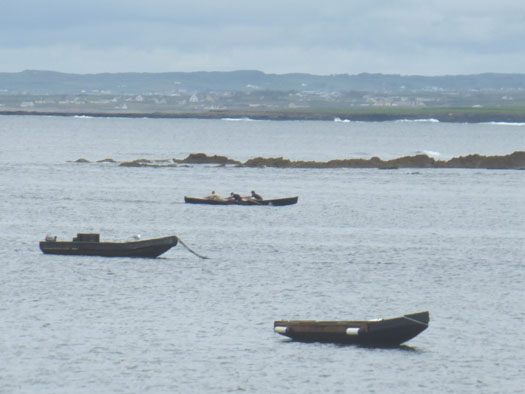
The western way. Racing currach at Doonbeg in training on Sunday morning. Photo: W M Nixon
One local boat which definitely won't be at today's Querrin Regatta is the reason we ended up in Kilrush in the first place. This is Steve Morris's own special pet, and it was Kim Roberts of Askeaton who suggested that this was worth seeing. It certainly is. He has taken a classic Harrison Butler Khamseen design, which is remarkably like an anticipation of Lyle Hess designs like Fred Schotman's Raven from the Netherlands which was in Dublin Bay last year, and is creating his dreamship at home.
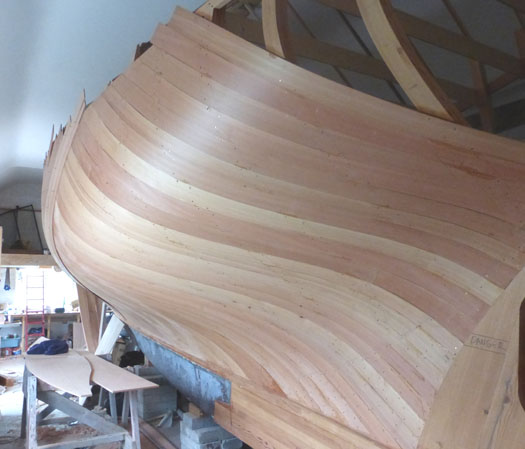
The port side of Steve Morris's 31ft Harrison Butler design looking forward, with the rich texture of the Alpine larch glowing through. Photo: W. M. Nixon
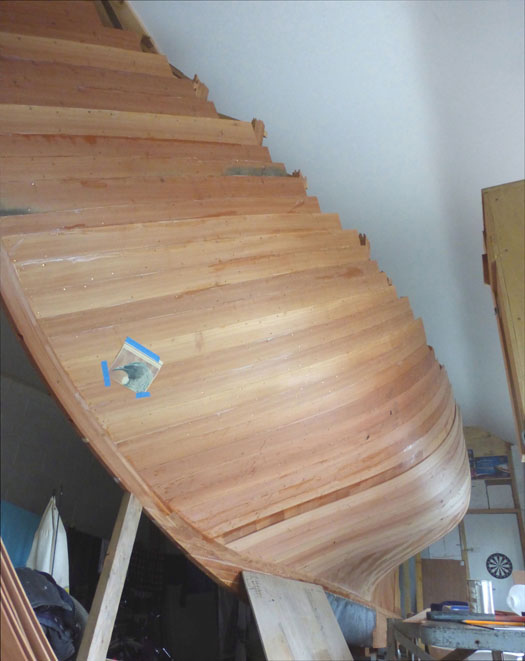
Don't try this at home.....Steve Morris has managed to fit this 31ft hull into the garage beside his house. Photo: W M Nixon
Steve is building this honey of a boat in multi-skin, using dark dense Alpine larch, the leftovers of a consignment of timber which was brought in from Austria for the building of Jeanie Johnston. The man works so neatly that he has managed to fit the entire project into the admittedly spacious garage beside his house near Moyasta, and the workshop is one of those spiritually-enhancing places which are a balm for the soul.
Particularly impressive is the perfectly-shaped lead ballast keel which fits so well into Harrison Butler's flowing lines. And it's typical of this job too. For when I asked him who made the form and cast the keel for him, he was surprised by the question, as the answer simply is: "I did it myself, right here on site".
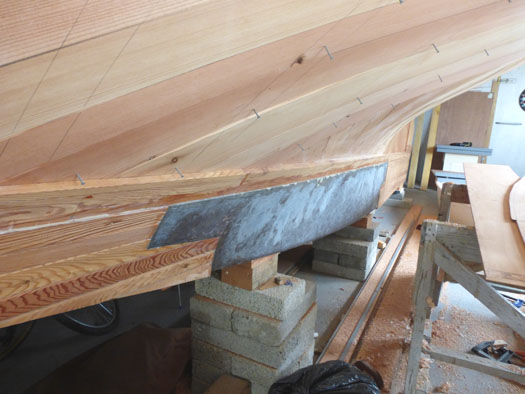
"No problem". The lead ballast keel was cast on site. Photo: W M Nixon
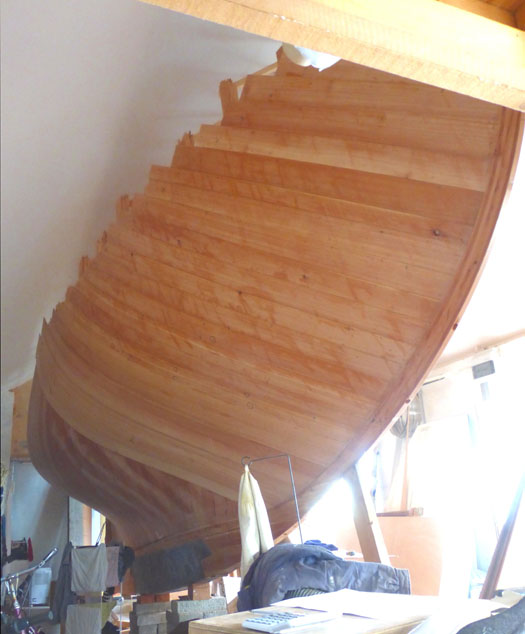
Even with quite a large garage, it's very difficult to get a photo showing all of a 31ft boat. Starboard side looking aft. Photo: W M Nixon
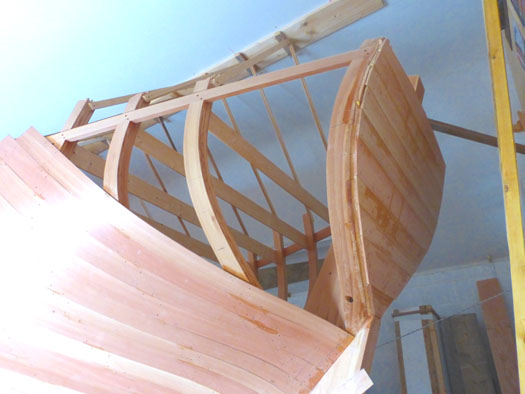
Although the Metacentric Shelf theory of hull design to which Harrison Butler subscribed has been large disproved, he still produced hulls of balanced performance with transom sterns which didn't drag half the ocean after them. Photo: W M Nixon

A dartboard is an essential in any boatbuilding shed. You need something to keep you well away from the job while glue is setting. Photo: W M Nixon
Using "leftover" timber for boat-building projects is an appropriate theme as we emerge from recessionary times. After John Kearon and his team had made such a fine job of conserving Asgard, there were bits and pieces of well-seasoned leftover wood, and they provided enough timber for Pat Murphy and his group of support volunteers to put in train the building of a replica of Asgard's original 1905 10ft dinghy, designed by Colin Archer himself.
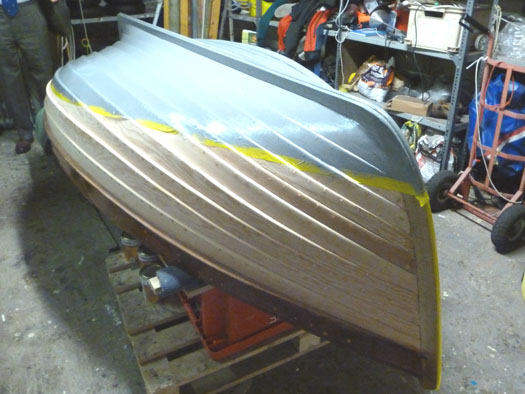
Asgard's dinghy starts to get the finishing treatment. Photo: W M Nixon
It was Fingal boatbuilder Larry Archer (absolutely no relation to the great designer, we're told) who put the little boat together. Like Myles Stapleton when he was tidying up the original drawings of Asgard's lines for a book two decades ago, Larry was very impressed with the way Archer's mind worked, as he designed the transom of the little boat to sit clear of the water when carrying a normal load, thus enabling her to slip easily along without leaving a wake like the inside of a washing machine.

Pat Murphy with Asgard's dinghy. After leading the creation of this little beauty, he understandably has mixed feels about putting her in rugged salt water. Photo: W M Nixon
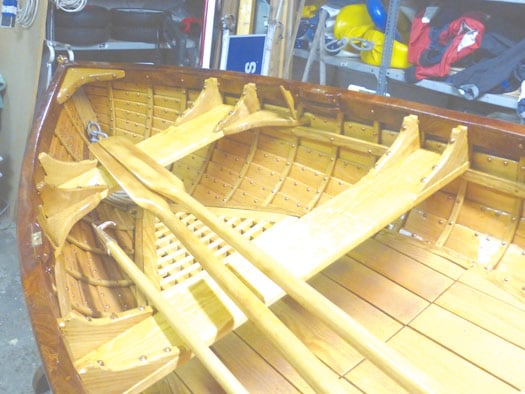
Classic construction and finish detail up forward. Photo: W M Nixon

The interior in the stern – for a ten footer, she is remarkably detailed, particularly where the required twist is put into the planking to maintain a sweet run aft. Photo: W M Nixon
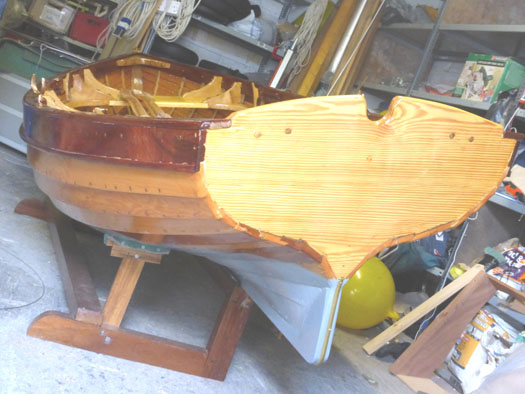
With a clever design to keep the transom clear of the water when the boat is carrying a normal load, Colin Archer created an easily driven yet workmanlike hull. Photo: W M Nixon
It's a remarkable bit of boat design, but with the dry timber it was the very devil to build in the necessary twists.. However, it was done in the end, and the new boat emerged in all her glory, exquisitely finished in classic varnishwork by Pat Murphy and George Elliott, with Neville Maguire making an impressive job of restoring an old set of oars to match the style.
Public debut – Agard's dinghy at Howth Prawn Festival. Photo: Pat Murphy
Asgard's dinghy made her public debut at the Howth Prawn Festival a fortnight ago, and was a star of the show. But the trouble is that when you get a boat finished to this standard, the very thought of putting her into rugged salt water is not appealing. Pat and his team accept the fact that the Asgard dinghy will have to go afloat for the Erskine & Molly Childers Asgard Centenary at Howth on Sunday July 27th. But for now they're much happier just admiring this gem as she shines in the shed, safe from the sea. And who can blame them?
#irishsailing – After five years of economic contraction, there are signs of recovery, and the 2014 Irish sailing season has also got off to a flying start. W M Nixon looks at various signs of new energy and initiatives, and sees how they might be affecting stories which have been run on this blog and in the Afloat.ie website during the past year. But he concedes that further cost reductions will be necessary for the good of the sport.
A year ago, any talk of green shoots in Ireland was almost entirely metaphorical. And it was in the economic sphere, though even there they were still few and far between, with many soon stunted. But out in the farmers' fields themselves, out where the grass should have been growing, there was scarcely a sign of life as we were still trapped in the coldest and most miserable Spring in living memory, and all forms of growth and recovery were blighted by it.
Sailing and boating, of all sports, are the most affected by Ireland's climatic conditions. Not only is the mood among participants strongly influenced by weather which sometimes can get anyone down, but without reasonable breezes, sailing events are seriously impaired. "We got a result!" may well be the PRO's final desperate claim after pulling some sort of a points table and leaderboard out of a series bedevilled either by too much or too little wind. But it's so much better to have a series bathed in sunshine and blessed by fine breezes, with enough races sailed for the crews to go home tired but happy without needing recourse to any of those weasel words which show you're only trying to justify a weekend of frustration.
Things could not be more different this year. The Spring of 2014 has been perfection, boats are going afloat on time and in reasonable weather conditions, and the first little crop of events and results are very encouraging indeed - so encouraging, in fact, that "little crop" doesn't do them justice.
That said, two of the nearer events which gave special cause for Irish celebration did not have perfect weather throughout. The Youth Sailing Nationals at Howth may have ended on a high with a great breeze in an early taste of summer sunshine, but one day out of the four was lost to bad weather. But the sting of that was lessened by the decision for "no racing all day" being taken at 1100hrs, which allows other leisure options to kick in.
The IRC Easter Championship in the Solent concluded through Easter Monday literally with "Darkness at Noon" – the heavy clouds and torrential rain on an almost windless day saw the final races being sailed with nav lights on. But there had been excellent racing on earlier days, and a very excellent result with Anthony O'Leary's Ker 39 Antix from Cork the clear supreme champion.
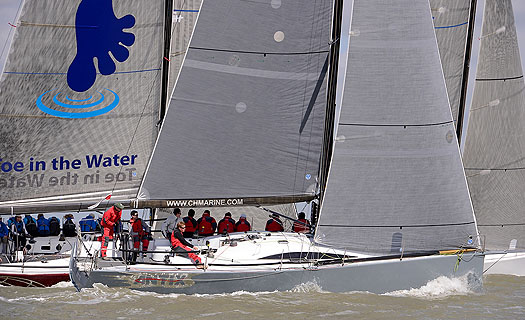
Doing the business. Anthony O'Leary's Ker 39 Antix settling into the groove on the way to the top place in the Easter IRC Championship. Photo: Rick Tomlinson
That in turn augured well for Ireland's Commodore's Cup chances, which then received a further boost last weekend when the crew of another Irish team wannabe, Quokka with Michael Boyd and Niall Dowling, had a winning weekend in the Warsash series with their temporary mount Tarka in anticipation of Quokka's return from the Caribbean at the end of May.

The Colours Match team racing between UCD and Trinity served up top sport in the Liffey, with Trinity winning. Photo: W M Nixon
Meanwhile the universities racing has been brought to life, for although UCD had a convincing win in the racing with the SailFleet J/80s to become the Irish team for the Student Yachting Worlds in France in the Autumn, before April was out the Colours Match in the Liffey under the burgee of the Royal Alfed YC, team-raced in Fireflies, saw Trinity take the honours in convincing style.
But if we're looking for something which really did set things freshly alight, it was out in Hyeres where the ISAF Championship saw the northern duo of Ryan Seaton & Matt McGovern take silver in the 49er, almost immediately moving them up the global rankings from 33 to 11, a quantum leap and no mistake.
The potential for serious success by these two has been fairly obvious for some time, but anyone who sails boats will know only too well how many factors have to come into alignment to get you up among the magic metals at the end of the day.

Stars of the silver sea – the Seaton/McGovern team took a silver medal for Ireland at Hyeres.
That their new global status was almost immediately acknowledged by this rankings improvement will in turn add heft to everything they do and say. Thus when, some time ago, the Ryan/Seaton equipe suggested that the 2016 Olympics sailing waters in Brazil are so off the standard as to be a health hazard, it attracted polite attention. But now that they're Number 11, and still counting down, much more notice is taken. And the fact that the Vice President of the International Olympic Committee has suggested, with something approaching despair, that the facilities in Brazil just aren't going to be ready for 2016 at any standard, all gives added legs to the statement from Ireland's 49er crew.
This in turn makes us wonder where world sailing might go in 2016 if the Brazilian setup is still Work in Progress. With tongue only slightly in cheek, we suggest they need look no further than West Cork, where Baltimore Sailing Club has been expanding its facilities to meet increased demand as a club which last year introduced something like 700 people to sailing. That BSC and current Mitsubishi Motors "Club of the Year" Kinsale YC further east along the West Cork coast have both been putting in premises up-grade during the past year, while other clubs have been having it tough, and just about hanging in there in some cases, surely gives pause for thought.
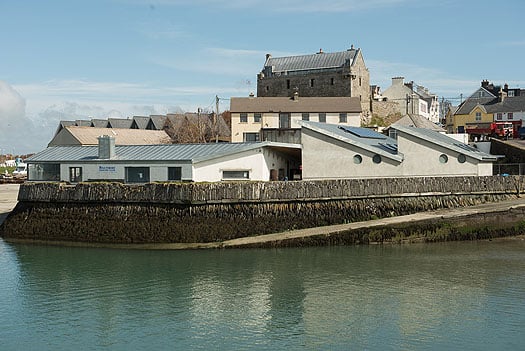
Olympic venue? The extended and up-graded Baltimore Sailing Club is ready and raring to go.
The economic shakeout of the past five years has caused a massive write-down in the value of almost all property and other assets. And in the case of yacht and sailing clubs, there has been a detailed examination of the continuing validity, or otherwise, of established yacht clubs and their traditional business model of quite high subscriptions under-writing other facilities which in turn combine to provide the complete package of an orthodox yacht club.
Inevitably, most clubs are run by officers and committee members who have been involved with the club for many years. Thus, like people who have been running a quality hotel for decades, they may have an inflated notion of what their organisation and its premises are actually worth. Admittedly there's only limited usefulness in comparing a yacht club with a hotel, but lessons can surely be learned. The fact is that hotels today are worth maybe only a third or even less of what they were reckoned to be worth six years ago. And equally, while yachts clubs certainly have a unique package to offer, is it unusual enough and special enough to charge high subscriptions when there are alternative facilities and services available?
The dilemma arises to some extent in all sailing centres. Last week we were discussing the story of the development of Howth YC. Today it is in the seemingly happy situation of having its own marina, thus it theoretically can offer an attractive all-in-one package to any potential member. But the very fact that Howth YC has done so much to help make Howth a colourful and vibrant sailing/fishing port is partly to its own disadvantage. The place has developed as a remarkable focus for top seafood restaurants. This means that the extensive club catering facilities – expected by traditional members - are constantly battling for business with a whole slew of award-winning eateries and characterful pubs nearby.
The problem is more acute in Dun Laoghaire in that the only club within the marina area is the Royal Irish YC. Thus while people may have been loyal members of the National, the Royal St George and the Dun Laoghaire Motor Yacht Club, they find that after going out in the boat, it's very easy to round out the evening aboard in the marina, chatting among themselves or with other crews on boats nearby, and then head straight for home without making their number in their home clubs at all.
This situation is less in evidence at weekends and during special events. But nevertheless it was causing such a lessening in mid-week club vitality that various steps have been taken, and the Royal St George's move to take over berths in a block booking in the outer marina, and service them by a frequent ferry direct from the clubhouse, is a visionary step.
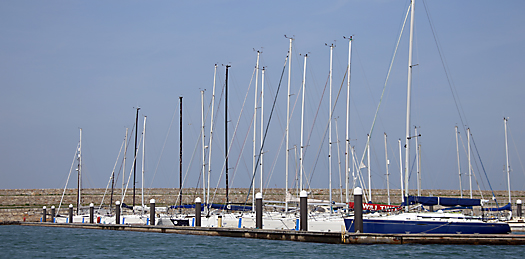
The Royal St George YC has introduced a direct ferry service from the clubhouse to its group of berths in the outer marina in Dun Laoghaire. Photo: David O'Brien
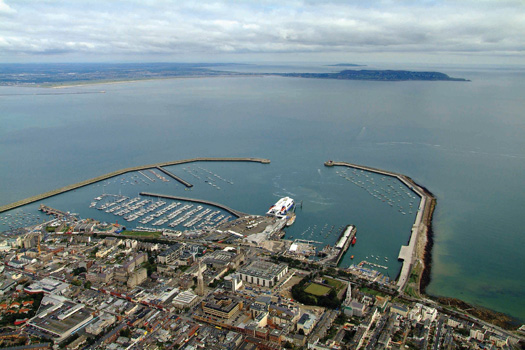
To overcome a lack of direct access to the Dun Laoghaire Marina, the Royal St George YC is running a ferry service from its clubhouse (to right of Stena Ferry, foreground) to the berths in the Outer Marina (upper left) Photo Kevin Dwyer/courtesy ICC.
Nevertheless, in all club administrations there are those who are of the opinion that, whatever the Honorary Treasurers may believe, there has to be a radical re-think of the primary subscription levels. In essence, they're suggesting that the book value of the club has to be written down such that subscriptions are halved. Personally, I haven't much of a notion of how to read a balance sheet, but the dogs in the street know that in the hospitality industry – which, in the broadest sense, is the area in which yacht and sailing clubs operate – values have been savagely slashed, and while charges may still seem high, at least the places are surviving as going concerns.
With continuing reduction in expenses across the board, one area in which there seems to be much work afoot is in the Irish Sailing Association, which in latter days had begun to seem like some hidden corner of the civil service, existing more for the benefit of staff than for the provision of services for sailors. It's amazing to learn that the ISA has sixteen fulltime staff, and a basic annual wages bill of something like €600,000. When you add in the expected benefits, it musty come in total to a very tidy yearly sum.
What on earth do they all do? While you'll invariably find the ISA logo in prominence at some top events, it has to be said that you're entirely unaware of the organisation's existence in any form at more everyday happenings, and it doesn't seem to be because they believe in doing good work by stealth. But with special study groups resulting from the major changes introduced in the ISA setup at the AGM in March, we can only hope that in time the Association will reflect the cost-cutting which has had to be introduced in the clubs, which provide the main part of the ISA's income.
While the administrative structures are rightfully being pared back in many areas of our sport, the coastal infrastructure, on which all forms of seagoing ultimately depend, continues to need maintenance and development. In this area, one very promising green shoot is the news that there are signs of movement in Dunmore East. A dredging programme is getting under way, and just this Tuesday, Minister for Marine Simon Coveney TD convened a meeting in the port to inaugurate a community approach to harbour development which, it is hoped, will help to invigorate the many places around Waterford Estuary, for which Dunmore East has the potential to be the true gateway harbour.

Dunmore East – can it fulfil its potential as the gateway leisure port for the Waterford Estuary? Photo Kevin Dwyer, courtesy ICC
In a more extreme marine environment, it has been confirmed that €6 million will be spent on improving the pier at Doolin in northwest Clare, the nearest mainland quay to the Aran Islands, which also caters for the tour boats cruising along the Cliffs of Moher. While the locals seem well pleased, I wouldn't get too excited about it. This is one very rugged part of the coast, and when you remember that it took €31 million to extend the pier at Kilronan in Inismor, the main Aran island, and another €14 million to build the little harbour at the north end of Inis Meain, the middle Aran island, then we can only hope that €6 million is going to achieve something more than a few boulders being shifted about in the roaring ocean at Doolin.

The pier at Doolin is decidedly minimalist, but it provides the shortest sea passage to the Aran Islands. Photo: W M Nixon
But then, in the west all things are possible, and along the ocean seaboard we're told that four thousand signs are being erected to guide people along the Wild Atlantic Way, the new tourism initiative using many smaller coastal roads. Quite so. Frankly, with signage at this level, it will be the Tame Atlantic Way by the time half of them are in place. I have to admit to being a complete curmudgeon in this. In many years of transitting Ireland's west coast by sea and land, one of our favourite areas while driving along the west coast has long been the coast south of Kilkee down to Loop Head, where the cliffs comfortably rival anything the vulgar Cliffs of Moher have to offer, and it is magnificently uncrowded. But not any more, if the Wild Atlantic Way movement has its way.
While I appreciate that visitor numbers have to be kept up and increased whenever and however, it has to be done in a way which appreciates that's what brings people to Ireland (rather than just to Dublin, which is a special case) is an unspoilt landscape. So, four thousand signs just for the one Atlantic Way? Ogden Nash had something to say about this:
"I think that I shall never see,
A billboard lovely as a tree.
But then, until the billboards fall,
I'll never see a tree at all".
Be that as it may, the final sign that suggests things are on the move again is a notice I spotted recently posted at a nearby club, though language pedants might wonder how a notice which manages to mangle so utterly the plural of "dinghy", even to adding a completely superfluous greengrocer's apostrophe, could be seen as encouraging in any way whatsoever.
Well, once you've overcome your opinions about the errors, the underlying message must be good news. More youngsters are evidently coming to sailing this year. And as for the spelling mistake, even that's an improvement. A year ago, the same notice board opened by referring to something called "a dingy", but this time round we have to get to the second line before finding that. And it all comes right for dinghies in the end.
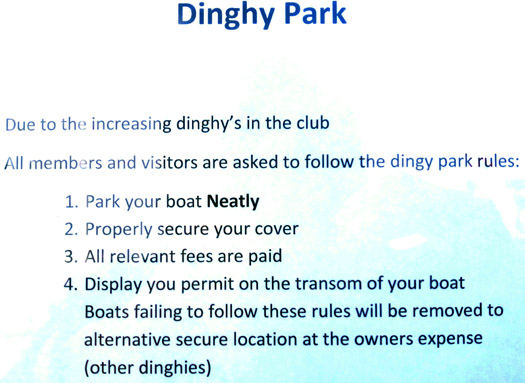
Sign of the times? Whatever about the spelling, this current notice at an Irish sailing club has an underlying message of good news. Photo: W M Nixon
Strengthen Fingal's Freedom for the Good of Irish Sailing
#fingal – The Government's recent move to create a framework for the direct election of a new all-powerful Mayor for Dublin was expected to be a shoo-in. The new Super-Mayor's authority would incorporate the current four local councils of Dun Laoghaire-Rathdown, South Dublin, Dublin City, and Fingal, each one of which had to vote in favour. But Fingal's councillors voted firmly against it, despite emphatic support of the proposal by the councillors in the other three areas. As a Fingallion by adoption, W M Nixon strongly supports this independent move by a largely rural and coastal region which has a longer shoreline than all the other Dublin areas put together, and is clearly not a naturally integral part of the city.
Fingal is the Ukraine of Leinster, and the glowering monster of Dublin is the Russia within Ireland, intent on the conquest of its smaller freedom-seeking neighbour. Vigorous, all-powerful, intensely urban, and distinctly impressed with itself, Dublin is certain that the further its bounds are spread, the better it will be for all its citizens. And the more citizens it can claim, then the better for Dublin.
But Fingal is different. For sure, it can seem a bit sleepy and rural by comparison with central Dublin, but that's the way we like it. It's a place of odd little ports and much fishing, a region of offshore islands, rocky coasts and many beaches on one side, and the profound heart of the fertile country on the other. A place where – as you move north within it - you might make a living in many ways at once, taking in growing vegetables, raising animals, running a dairy herd, and keeping a lobster boat down at the local quay, while perhaps having a horse or two as well. And if you feel like more shore sport, the golfing options are truly world class.
As for the sailing and all other forms of recreational boating, Fingal is not just a place of remarkable variety – it's a universe. With five islands – six if you count Rockabill – its 88 kilometre coastline is one for sport, relaxation and exploration. Sea angling is well up the agenda, and it's a kayakers' paradise, while Irish speed records in sailboarding and kite-surfing have been established in the natural sand-girt canal which forms for much of the tidal cycle in the outer Baldoyle estuary immediately west of Howth.
Apart from fishing boats – and inshore they're usually only the smaller ones – it has no commercial traffic. And though there are tidal streams, in southern Fingal's main racing area between Ireland's Eye and Lambay, they're not excessively strong, and run in a reasonably clear-defined way, while the flukey winds which so often bedevil Dublin Bay away to the south are much less of a problem in sailing off Fingal, where the winds blow free.
The range of boat and sailing clubs of Fingal matches the variety of its coast. The most southerly is Sutton Dinghy Club, rare among Ireland's yacht clubs in being south-facing. It may be focused on sailing in Dublin Bay, but scratch any SDC sailor, and you'll find a Fingallion. Round the corner of the Baily – not a headland to be trifled with - Howth has two clubs, the yacht club with its own marina, and Cumann na Bhad Binn Eadair (the Howth Sailing & Boat Club) in the northeast corner of the harbour, while Howth Sea Angling Club with its large premises on the West Pier is one of the tops in the country.

The sunny south. Sutton Dinghy Club is Fingal's most southerly sailing club, and is also rare in Ireland through being south facing.
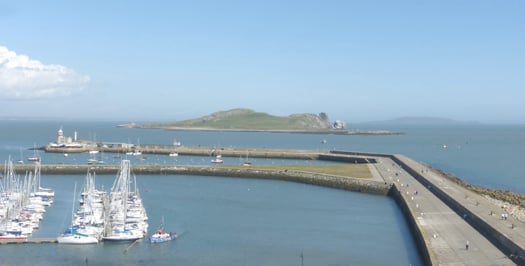
Islands of Fingal seen across the eastern part of Howth marina, with Ireland's Eye in the foreground, and Lambay beyond. Photo: W M Nixon
As for the waters they share, their most immediate neighbour is the steep island of Ireland's Eye with its pleasant southwest-facing beach, the island itself a remarkable wild nesting site, particularly when you remember that it's close beside an intensely urban setting. When a discerning visitor described Ireland's Eye as "an astonishing and perfect miniature St Kilda", he wasn't exaggerating.
Across in Malahide, where we find Fingal's other marina, Malahide YC - which recently celebrated its Golden Jubilee and currently has Graham Smith as its first second-generation Commodore – is in the curious position of having two clubhouses. One is a charming and hospitable place among trees within easy stroll of the marina, while the other is west of the long railway embankment which retains the extensive inner waters of Broadmeadow. This makes the waters into a marvellous recreational amenity and boating and sailing nursery, so not surprisingly it is home to active sailing schools. And it is also the base of Malahide YC "west", a dinghy sailing club on the Broadmeadow shore at Yellow Walls, while further west of it again is yet another club, the more recently formed Swords Sailing & Boating Club.

The map of modern Fingal shows how the southwest corner of the present region seems remote from the largely coastal and rural nature of much of the rest of the county. And it also confirms the surprise (to many) that the Phoenix Park is in Fingal.
North from Malahide, and you're into "Fingal profonde", its deeply rural nature occasionally emphasised by the sea nearby. The long Rogerstown Estuary, the next inlet after Malahide, sometimes found itself providing the northern boundary of The Pale, and as recently as the early 1800s the river at Rogerstown and the tiny port of Rush were a veritable nest of smugglers, privateers and occasionally pirates, with buccaneering captains of myth and legend such as Luke Ryan and James Mathews proving to have been real people who were pillars of society when back home in their secretive little communities after their lengthy business forays to God know where.

Muddy situation. Low water in the Rogerstown Estuary. The hill in the distance on the left is new – for years, it was the largest dump in Ireland, the Balleally Landfill. But now it is well on its way to rehabilitation as an enhancement of the landscape. Photo: W M Nixon
The Rogerstown Estuary went through an unpleasant period when its inner waters were dominated by the nearby presence of the biggest waste dump in Dublin, Balleally Landfill. It rose and rose, but now it's closed, and is in process of being revived to some sort of natural state. The result is that the vista westward from Rogerstown is much improved by a pleasant and completely new hill which so enhances the view at sunset that shrewd locals have built themselves a row of fine new houses facing west, along the quirkily named Spout Lane which runs inland from the estuary.
Whatever about the legality-pushing privateer skippers who used Rogerstown Estuary as their base in days of yore, these days it's home to the quay and storehouse which serves the ferry to Lambay, which is Fingal's only inhabited island when there are no bird wardens resident on Rockabill, and it's also the setting for another south-facing club, Rush SC. It is spiritual home these days to the historic 17ft Mermaid Class (they still occasionally build new ones in an old mill nearby), but despite the very strong tidal streams where the estuary narrows as it meets the sea, RSC also has a large cruiser fleet whose moorings are so tide-rode that unless there's a boat on the buoy, it tends to disappear under water in the final urge of the flood. This can make things distinctly interesting for strangers arriving in and hoping to borrow a mooring while avoiding getting fouled in those moorings already submerged. Not surprisingly, with their boat sizes becoming larger like everywhere else, Rush SC find that their bigger cruisers use Malahide Marina.
To seaward of Rogerstown, with the little port of Rush just round the corner, the view is dominated by Lambay. A fine big island with is own little "miniature Dun Laoghaire" to provide a harbour on its west side, it has a notable Lutyens house set among the trees. But for many years now Lambay has been a major Nature Reserve, so landing is banned, though anchorage is available in its three or four bays provided you don't interfere with the wildlife along the shore. This makes it off bounds to kayakers who might hope for a leg stretch on land, though it's still well worth paddling round close inshore.
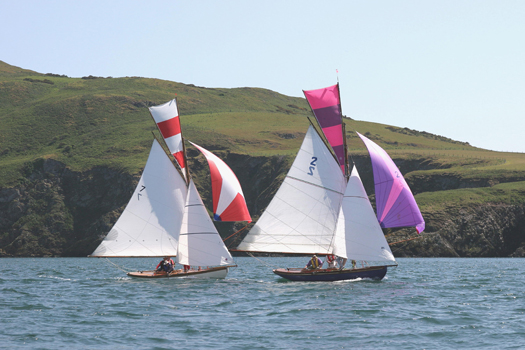
Racing round Lambay. Close competition between the Howth 17s Aura (left) and Pauline, which have been racing annually round Lambay since 1904. Photo: John Deane
Along the Fingal mainland coast, the next inlet after Rush is Loughshinny, a lovely natural harbour with a quay to further improve the bay's shelter. There's a very active little fishing fleet, while the shoreside architecture is, how shall we say, decidedly eclectic and individualistic? Go there and you'll see what I mean.
Six miles offshore, Rockabill marks the northeast limits of Fingal. It's a fine big double-rock, with a substantial lighthouse and characterful keepers' houses attached. But as it's now automated, the only time Rockabill is inhabited is for the four summer months when a bird warden or two take up residence to monitor the rocky island's most distinguished summer residents, Europe's largest breeding colony of roseate terns.
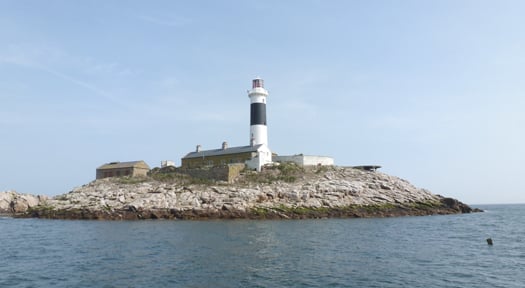
Rockabill, where the shy roseate terns feel at home. Photo: W M Nixon
In Fingal we tend to take these pretty but noisy summer visitors for granted, but the word is that south of Dublin Bay the tern buffs are so incensed by Rockabill having a clear run that they're tried to start a rival colony of roseate terns on the Muglins, and built a row of tern houses (one good tern deserves another) to facilitate their residence. The potential nest sites may not have survived the past severe winter. But in any case, one wonders if they had planning permission from Dun Laoghaire/Rathdown council for this development? Persons suggesting that such a development would almost certainly be terned down will not be given any attention whatsoever.
Skerries and Balbriggan are the two main sea towns of north Fingal, and they're as different as can be, the difference being emphasised by historic rivalry. It's said that back in the government harbour-building days of the late 19th Century a grant was made available to assist local landowners to make significant improvements to one of the harbours, and this meant war.

Balbriggan may very definitely dry out, but it provides a secure home port for both trawlers and other boats prepared to settle on the mud and sand. Photo: W M Nixon
So eventually the grant was split with half going to improve Balbriggan, and the other half to Skerries, with neither being a total success. If you seek total shelter in either today, you have to be prepared to dry out, while the anchorage off Skerries is also subject to a large tidal whorl which means that when the ebb is running in a strong onshore wind, the moorings are doubly rough and diabolically uncomfortable. And every so often after an exceptional nor'easter, we have another litany of boats driven ashore and Skerries yacht insurance going even further through the roof.
It's a situation which needs proper attention from an administration which is genuinely interested in the port. And the proper development of the harbour at Skerries, while retaining the little old place's special character, is surely something which could be much better done by Fingal Council rather than some remote Mayor of Dublin for whom Skerries will be the outermost periphery, a place seldom visited, if at all.
We've seen it all before. Time was when Fingal was simply the North County, little noticed in the centres of power which were basically Dublin City and Dublin County, their head offices in the heart of the city. But then in 2001 the new four-council setup was created, and the old name of Fingal – never forgotten by those who cherished the area – was revived. A very fine new user-friendly County Hall – it has even been praised by Frank McDonald of The Irish Times – was built in the re-born county town of Swords. Out on the new boundaries meanwhile, the signs went up saying "Welcome to Fingal County". But we old Fingallion fogeys pointed out that as Fingal means "Territory of the Fair Strangers" (i.e the Norsemen rather than the Danes), it was superfluous to be describing it as "the county of the territory", so these days it's just Fingal, and we're happy with that.
Here in Howth, we sort of slipped into acceptance of the new setup. Once upon a time, from 1917 to 1943, Howth had its own Urban District Council. It says much for the place's remoteness from the world that the HUDC was established in the midst of one global war, and quietly wound up in the midst of another. In 1943, Commissioners had to be imposed on the tiny fiefdom to offset the fact that some local interests thought the HUDC existed entirely for their own personal benefit. So at various times since, Howth was run either by Dublin County Council, or even by Dublin City Corporation. We were assured that this latter setup was all to our benefit, as the powers-that-be in City Hall had a soft spot for Howth, sure wasn't it the place where the mammy went every Thursday evening to buy the family's fish, and wouldn't she want to see it looking well?
Maybe so, but when it came to doing something more useful with the harbour, Howth Yacht Club – having re-constituted itself in 1968 from an amalgamation of Howth Sailing Club (founded 1895) and Howth Motor Yacht Club (founded 1934) - found itself dealing with a bewildering variety of government departments as the lowly interests of fishing and its ports seemed to be shifted whenever possible by civil servants who reckoned that banging the drum on behalf of fisheries in particular, and maritime interests in general, was not a shrewd career move for anyone planning a steady progress up the very landbound Irish public service ladder to the sunlit uplands of a long and prosperous retirement.
So if at times absolutely nothing seemed to be happening in a harbour which was painfully inadequate for expanding boating and fishing needs, it was partly because the club officers and fishermen's leaders could find it difficult to discern just who in authority could or would make the decisive call. In those days it turned out to be somewhere in the hidden recesses of the Office of Public Works. Suddenly, in 1979, a plan for the major re-development of the harbour was promulgated at official level, with a radical rationalisation planned for its future use. The western part, it was proposed, would become totally fisheries, while the eastern part was to be given over to recreational boating, all of it involving major civil engineering and harbour works projects.
Looking at the successful harbour today, it all seems perfectly reasonable and sensible. But back in 1979 when HYC were presented with a time-limited take-it-or-leave-it choice, the way ahead was not at all clear. Friendships were sundered and family feuds emerged from the heated progress towards accepting the offer that the club agree to vacate its premises on the West Pier - a clubhouse which it had renovated and extended only ten years earlier – and commit itself to the installation, at members' cost, of a marina in the eastern harbour with the obligation to build a completely new clubhouse there.

Today's Howth Harbour didn't happen overnight. This is how it was from 1982 until the new clubhouse was completed in 1987. Photo: W M Nixon
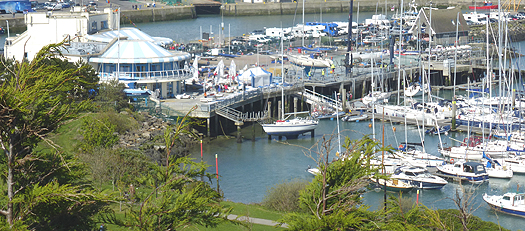
Multiple activities under way at Howth YC this week. The club's setup may seem only natural now, but it was quite a struggle to get there. Photo: W M Nixon
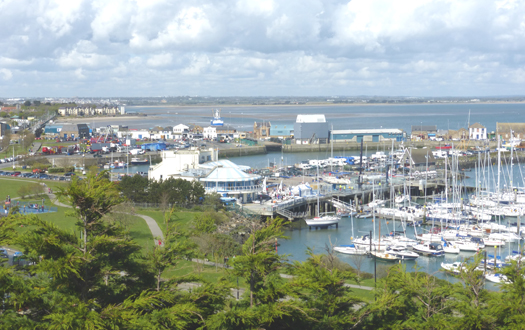
Howth's vibrant mix of a working fishing port and busy sailing centre has provided the ideal setting for the development of a successful visitor and seafood destination. Photo: W M Nixon
It's all history now, but it was done. And done so well by those involved that today it's simply taken for granted. Arguably, it's a compliment to those who created the Howth YC setup, that newer members should seldom wonder how it all came to happen, it just seems so right and natural. And as for those running the club, they in turn have to build on past achievements in dealing with an ever-changing administrative environment in which the changeover to being part of Fingal was only one of several evolutions.
Yet the recent attempt to abolish Fingal was a wake-up call. In Howth we may have wandered into it, but in just a dozen years, a dormant Fingal identity has come quietly but strongly awake. In Howth village it's natural enough, as our backs are turned to Dublin and we look to the rest of Fingal. But even on the south side of the hill, where fine houses face across Dublin Bay and you'd expect a sense of identity with households in similarly choice locations for all that they look north out of Dun Laoghaire, you find that the attraction of visiting the southside has the exotic appeal of going foreign, while those of us more humbly placed in the village, if visiting remote places like Rathmines or Terenure, find it positively unnerving to think of all the houses between us and the sea.
Then too, while Fingal Council has been establishing itself in our hearts and minds, it has been a good time for Howth Harbour. Good fences have been making good neighbours, and though marine administration in government has been kicked from pillar to post, an underlying Department of Fisheries recognition that their harbours cannot be only about fishing has led to a re-think on the use of buildings about the harbour, with Howth becoming an extraordinary nexus of good seafood restaurants, such that on a summer evening, despite the presence of a traditional fish and chip shop, the seafood aroma is of a proper fishing port in Brittany or Galicia. In fact, rents from the hospitality and sailing and marine industries in Howth have now reached such a level that fish landing fees – formerly the bedrock of the harbour economy – only contribute about 10% of the overall income.

The man from County Hall. Fingal Mayor Kieran Dennison is comfortable with his county's busy sailing activities, and the sailors are comfortable with him. He is seen here officially opening the J/24 Worlds at Howth in August 2013. Photo: W M Nixon
As for how we've been getting on with our new masters in County Hall up in Swords, the news is good. Most recently, we've been having direct contact with the current Mayor of Fingal, Kieran Dennison, who hit just the right note when he officially opened the J/24 Worlds in Howth in August 2013. Following that, he was back at the annual Commodore's Lunch in HYC in the dark days of November when a review of the past season lightens the onset of winter, and he was able to tell us that thanks to contacts made at the Worlds, his invitation to visit the America's Cup in San Francisco in September was made even more enjoyable. Those of us who reckoned the only way to visit the 34th America's Cup was on the television screen were reassured by the thought that if somebody was going to represent us in the San Francisco bear-pit, then our Mayor, our very own Mayor of Fingal, was just the man for the job.
So we very much want to keep Fingal in existence and in robust good health, but we appreciate that its current boundaries might be creating a bit of a Ukraine-versus-Russia situation. In particular, the southwest of the county could well be Fingal's Crimea and Donetsk regions. There, relatively new settlements of ethnic Dubs in places like Clonsilla, Castleknock, Blanchardstown could become such a source of trouble that it might be better to transfer them peacefully to administration by either Dublin city or South Dublin before there is unnecessary bloodshed.
The situation arises because, when the boundaries were being drawn, southwest Fingal was set out all the way down to the Liffey. The Fingallion instinct would be to see the border drawn along the Tolka, in other words the M3. But there could be trouble because of the discovery – always something of a surprise – that the Phoenix Park is in Fingal. I could see that when some people find our Fingal includes the Park, they'll want to fight for it, particularly as, in the southeast of the county, the excellent St Anne's Park in Raheny was somehow allowed to slip into Dublin City.
One thing which is definitely not for transfer is the Airport. It is naturally, utterly and totally part of Fingal. For sure, it contributes a fifth of the county's annual income from business rates, making Fingal the economically healthiest Irish county. But we in Fingal have to live with the airport very much in our midst. If Dublin really wants to take over the airport, then a first condition before negotiations even begin would be that all flight paths are to be re-routed directly over Dun Laoghaire and Dalkey. A few weeks of that would soon soften their cough.
Whatever, the recent kerfuffle about Fingal rejecting involvement in administration by an all-powerful Mayor of Dublin has been a powerful stimulant to thinking about how our own county might best be run. Everyone will have their own pet local projects, and most of us will reckon that decision-making in Swords, rather than in some vast and impenetrable office in the middle of Dublin, will be the best way to bring it about. For those of us who go afloat, the fact that Fingal Council shows that it cherishes its long and varied sea coast, rather than preferring to ignore it, is very encouraging. And the fact that this prospering county has some financial muscle all of its own gives us hope that we can build on what the past has taught us, and spread improved facilities to every port. Should that happen, it will in turn benefit Irish sailing and boating generally to a greater extent than would restricted development under one closely-controlled central administration headed by some southside megalomaniac.
America's Cup Could Cost San Francisco's Taxpayers
#AmericasCup - The America's Cup could cost the city of San Francisco up to $20 million, according to Phillip Matier and Andrew Ross in the San Francisco Chronicle.
The columnists reckon that fundraising efforts to raise the close to $34 million needed to cover the event's expenses "have pretty much hit the wall at $14 million" - leaving an already cash-strapped city to potentially pick up the shortfall.
San Francisco's fundraising issues have echoes of Galway's hosting of the Volvo Ocean Race last year - an event that was a rousing success itself, but one that left race organisers in debt by nearly half a million euro.
Afloat.ie's own WM Nixon wrote at the weekend that "it's time for a reality check" for San Francisco with some notes to go before the first yachts race in the bay.
While he believes that the event will be a sell-out, "it's not a question of whether or not the tickets sell out. Rather, it's a matte roof how quickly, and to whom, and for how much."
The America's Cup – Sailing's Sacred Monster
#americascup – The America's Cup is a sacred monster, hellbent on devouring its own followers. That is part of its awful fascination. You play with fire if you get involved with this "greatest" of sailing's sporting challenges. Either you succeed in using it for your own purposes, or it uses you and dumps you afterwards. No-one, but no-one, goes through the experience unmarked.
Its history includes a litany of personal tragedies such as suicide, bankruptcy and jail. And major international diplomatic rows for good measure. Entire reputations are won and lost with it. Yet once again, here it is, 2013 and an America's Cup Year. Like it or lump it, this is the tops. The America's Cup is the peak of our sport. Alas.
We only have to look at the history of Irish involvement to get the flavour of it. First one into the fire in 1886 was William Henn, whose family owned property in County Clare and lived in Paradise House on the estuary of the Fergus River southwest of Ennis. Henn challenged with Galatea, a large (102ft) comfortable performance cruiser, designed by Beavor Webb who'd been born in Enniskillen.
Seagoing comfort was a good idea in those early days of challenging, as the defending Americans insisted the challenging yachts should sail on their own bottoms across the Atlantic, just as the America herself had sailed to Europe in 1851. But Galatea was outsailed in light winds for the Cup races. So the gallant Lieutenant Henn and his supportive wife and their ship's company (including Peggy the pet monkey) stayed in America and lived aboard the Galatea in the hope of stronger winds for another challenge the following spring. They lost those races as well, but their winter presence in America had fascinated the rapidly developing newspaper industry, and reinforced the tendency where the people involved, their private lives, and the source of their funding, is of as much public interest in the America's Cup as the yachts and sport itself.
It's said that the remains of Galatea can still be discerned in the Fergus Estuary – certainly Conor O'Brien, another Shannon Estuary sailor, mentioned her as being anchored off Paradise House. The house itself is now a derelict overgrown shell, and the Henn family is long gone from County Clare.
Thereafter, America's Cup challenges became much more professional and inevitably controversial, and none more so than with Lord Dunraven from the other side of the Shannon Estuary, at Adare in County Limerick. His first challenge in 1893 used the G L Watson-designed Valkyrie II (117ft), but as this was the first time Nathanael Herreshoff had designed the defender, the peformance stakes were much raised, and Valkrie II suffered three straight defeats.
But Dunraven had got a taste for it, and though enormously wealthy (an ancestor had married a Welsh heiress whose property included several fields, all of them coalfields), he got together a syndicate of wealthy people, mostly Irish landowners, to support him in challenging again in 1895 with the new Valkyrie III.
This time round, public interest reached an all-time high, and Dunraven protested that the presence of large spectator steamers had hampered his boat's performance. Things got really nasty, the problem was never really resolved, the lawyers were busy, Dunraven was turfed out of his membership of the New York Yacht Club (an unprecedented event), and it all ended in tears.
Down the years, Lord Dunraven is remembered only as the prickly little aristocrat who got into an international row as a consequence of the America's Cup. It's true, but it's unfair. He was a man of prodigious energy, something of an inventor, and an enlightened landowner and employer. Despite the unpleasantness in America, he was remarkably successful in political negotiation and working towards agreement, although he was never a fulltime politician.
In 1902 he chaired the conference in Ireland which resulted in the establishment of the Land Commission, and thereby ended the Land League wars. It was a pivotal achievement in Irish history.
The shape of modern Irish agricultural life and the type and size of farms we have to underpin our rural society today is in part due to the patience, diligence, skill and understanding of Windham Thomas Wyndham-Quin, fourth Earl of Dunraven. Yet all he is remembered for is his troubles with the America's Cup.
Those troubles in turn saw his syndicate members distance themselves. Only thanks to the new Martin Black book on G L Watson do we now know that people like the McCalmonts of Mount Juliet in Kilkenny were financial supporters of the Valkyrie III challenge. But by this time it was big business, and with the unpleasantness left by the Valkyrie III affair, the way was open for a new challenger to bring peace and sportsmanship to the fore.
It tells us much about the good sense of John Jameson, the most successful owner of large racing yachts in Ireland in the late 19th Century, that he turned down all blandishments to get involved in the America's Cup circus. But then came Thomas Lipton, "the man who invented himself". From humble origins in Monaghan, rising through shops in Glasgow which became an expanding international retail empire, he saw the America's Cup as an opportunity, an attractive sporting challenge in which he could gain favourable publicity for the Lipton brand on both sides of the Atlantic.
Though all seemed bonhomie and good sportsmanship, Lipton could be quite ruthless in putting his five campaigns together, even though, in the end, none was successful You needed a recognized yacht club through which to challenge, so having failed to join the Royal Yacht Squadron through being in trade and because of his humble origins, as a Monaghan man he turned to the Royal Ulster Yacht Club in Belfast, who elected him with acclaim. But until then, the RUYC had got by without a clubhouse, though they had a starting battery in Bangor. Lipton insisted he needed a club with a clubhouse, so 30 of the 130 total membership of the RUYC divvied up to build a complete new clubhouse in Bangor in jig time, and it was finished in April 1899.
With hindsight, we can see that for the RUYC, the America's Cup challenge was the cuckoo in the nest. Already, some of the keenest sailing members had moved away to join a new club further up the lough, which soon became the Royal North of Ireland YC at Cultra. Meanwhile, the energies of the best administrators back in RUYC were being taken up with Lipton's first three challenges – in 1899, 1901 and 1903. Other forms of sailing were very definitely second fiddle in RUYC. Yet we now know that Lipton was not in the least grateful. It is said that he was only once in the fine new clubhouse built at his behest, though doubtless they'd have seen more of him if he'd won and the RUYC was defending. But as for his loyalty to RUYC, it was very flexible – we now know that in 1904 he was preparing another challenge through his new VBFs, the Royal Irish Yacht Club in Dun Laoghaire.
That failed to go ahead only because the design rules for the challenge could not be agreed between Lipton and the New York YC, and for his remaining two challenges in 1914-19 (war intervened), and 1931, Lipton returned to RUYC. He never did win the cup, though Shamrock IV could well have done it had the series gone ahead as planned in 1914 before the outbreak of the Great War. But his genial sportsmanship, sometimes a skilled act, worked well to gain favourable publicity for his retail business interests.
Direct Irish interest therefore ended in 1931, though in 1983 Cork's finest, Harold Cudmore, played a key role in the historic wresting of the Cup from the Americans after they'd held it for 132 years. John Bertrand helming the 12 Metre Australia II had the slightly faster boat, but defender Dennis Conner with Liberty was the more skilled helmsman-tactician, and this was most evident at the starts. The Australians called for a lay day, as they were entitled to, and provided Cudmore with a 12 Metre to go out and put the Bertrand/Australia II combo through a gruelling day of start training off Newport. In the best of seven series, the Americans had already won the first two races, but now Australia II clawed her way back with Bertrand's improved confidence at the starts. It was then the Americans who called for a lay day, and in all the series ran for 14 tense days until, on Monday September 26th 1983, America lost the America's Cup by 4 races to 3 after a neck and neck final race.
Dennis Conner then won the trophy back in one of the finest America's Cup series of all, off Perth, Western Australia in 1987. Subsequently, the highest level of Irish interest came through Michael Fay's New Zealand challenges which were made by someone who was proud to proclaim his Irish lineage at every opportunity. But the America's Cup has been won and lost and won again and lost again, almost despite other events of global concern. Wars have been fought, empires have fallen, fortunes have been made and lost, great crimes have been committed, man has walked on the Moon, and new forms of sailing have come to the fore. Yet despite the world in general and the world of sailing in particular changing out of all recognition, some 162 years after a fine schooner won a race around the Isle of Wight, the America's Cup is more than ever the peak of sailing. It defines the lives of all those involved with it, and as summer draws on we will all look with increasing and sometimes horrified fascination towards San Francisco and an epic battle between incredible 72ft catamarans raced at unbelievable cost.
RIOT ON REE
We had The Raid up the Erne and down the Shannon last September. Now we have the RIOT round Lough Ree and down the Shannon to Lough Derg, set for the last week of June this year.
RIOT is Round Ireland On The Inside. The inside is Lough Ree, beside which you can find the pillar marking exact centre of Ireland. It was put up by some Victorian worthies in Westmeath who had little enough to do with their time except work out sums, and calculate through a weird formula the location of the exact centre of the Emerald Isle. Putting up a pillar made it official, and good luck to them for doing so. That said, it might be interesting to use today's computers to see just how accurate they were.
But there's no rush to do so, and there has been no rush in promoting the idea of the Round Ireland On The Inside Race either. Alan Algeo has had the idea for a very long time. I can remember it being discussed at length (and towards no immediate conclusion) when were cruising Lough Ree back in 1998 on his 85ft barge Linquenda, in company with David Beattie's 47ft Dutch Lemsteraak Schollevaer.
Things have changed, however. Alan Algeo has now got his hands clamped firmly around the levers of power. He is Commodore of Lough Ree Yacht Club (founded 1770), and having already served one dutiful and awfully well-behaved year, he has earned the right to implement some of his own notions. Then too, he was one of the most enthusiastic participants in The Raid, sailing the 17 mile length of Lough Ree in a Shannon One Design in a minute or two over two hours, which is cooking with gas for sure, and gives him some right to suggest how much others should be able to achieve in the course of a day's sail.
Other factors are involved. The mighty Linquenda will be celebrating her Centenary. More of a ship than a barge, she was built as a heve-barge (a single-masted sailing vessel) in 1913 at Westervoort in order to serve as a hagenaar, that is plying the route to The Hague. She will make a superb mother-ship and committee boat for the RIOT, but there'll be more centenaries than that to observe, as the Schollevaer is also going to be marking her hundred years.
She'll have more than that to celebrate, for in the big freeze of 2010, one of her hull inlets split through ice pressure, and owner David Bettie returned to his waterside house on Lough Ree to see his beloved boat's mighty mast sticking up out of the icefloes, but with precious little else still visible. The restoration is ongoing, but we're assured Schollevaer will be there in prime order to mark a hundred years and a re-birth.
Another celebrant will be Dan O'Connor's fine motor-cruiser Harklow, marking her Golden Jubilee, as she was built for Douglas Heard by Jack Tyrrell of Arklow in 1963 to succeed Douglas's original inland cruiser, the converted lifeboat Hark with which he was the last skipper to pass through the Royal Canal in 1954, when it's eventual re-opening in 2010 would have been dismissed as a crazy dream. You will have guessed that Hark was Heard's Ark abbreviated, while the Harklow name acknowledged the Tyrrell input into the new boat using ideas learned from the old.
So the hope is there'll be more than enough in the way of big boats with lids and beds to provide hospitality for those on little boats with neither. Thus the RIOT really can undertake a series of extended passage races which will take the fleet right round Lough Ree in considerable detail and to many venues. Numbers will then be augmented come the weekend, with boats joining for the annual two day Shannon One Design Long Distance Race from Lough Ree down to Lough Derg, with an overnight at Banagher.
The details are still being finalized, but basically the RIOT starts with an informal assembling at Lough Ree YC in Athlone on the evening of Sunday 23rd June, and there's racing every day from Monday 24th June onwards, finishing at various places on the lake in a continuum, and getting back to LRYC on Friday June 28th.
Next day they race the first half of the Long Distance to Banagher, then it all winds up on Sunday June 30th at Lough Derg. Judging by the eclectic entry for The Raid, the RIOT will be of interest to boats of many types, indeed the fact that much of its is happening in Lough Ree will mean that keelboats can also be realistically involved. Lough Ree YC website is www.lryc.ie.
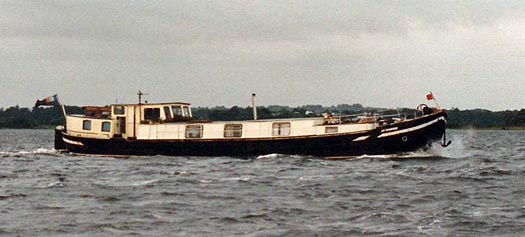
Lough Ree YC Commodore Alan Algeo's ship-like 85ft barge Linquenda will be celebrating her Centenary during the RIOT on Lough Ree at the end of June Photo: W M Nixon
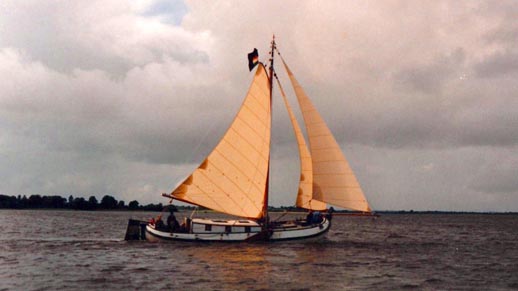
David Beattie's 47ft fully-rigged Lemsteraak Schollevaer has been restored, and will be sailing Lough Ree and the Shannon in June to celebrate her Centenary. Photo: W M Nixon
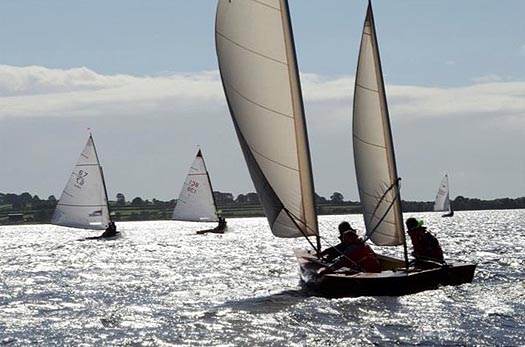
Two Shannon ODs and a ketch racing on Lough Ree in The Raid last September
BANKING ON AN ISLAND
Why on earth are people throwing up their hands in horror at the news that hundreds of thousands of tons of material extracted from tunneling in Dublin is going to be dumped about three miles out to sea just beyond the mouth of the bay? This isn't a problem. This is an opportunity.
It has long been obvious that the Leinster coast needs more islands. In watching Sean Cullen's fascinating presentation about the INFOMAR surveys in December at Poolbeg Y & BC, and in particular his computerized displays showing the details of Dublin Bay, it became immediately obvious that the Burford Bank is an island which is just waiting to happen.
Think of how much more interesting Dublin Bay would be with its own Sable Island stretching for a mile or two north-south out where the Burford is now awash, providing shelter and an anchorage and somewhere to see, and maybe even visit?
After all, it's not so long ago that the Bull Island simply didn't exist. Yet now, thanks to the limited technology of the 19th Century in building the North Bull Wall, there it is – the Bull Island is one of the most important, welcome and popular features of the entire bay.
So surely with 21st Century technology we can manage something, and further out in the bay at that. But before creating new islands, be mindful that Dublin Bay has lost at least one. There used to be a Clontarf Island, and you can still see the remains of a house that was reputedly on it when you turn right off the Alfie Byrne Road to go along the front of Clontarf towards Howth. It looks like the ribs of an old shipwreck, or even the framework of a wooden pier, but it's apparently the lower skeleton of the house still there, but the island long gone.
Clontarf Island was noted as a healthy place to be when Dublin was afflicted by plague, so in the 1830s a wooden summer house was built on it by a Dublin publican called Christopher Cromwell. He is said to have been a descendant of Oliver Cromwell, and no, I'm not making this up, but somebody else may well have done so once upon a time. Anyway, on the 9th October 1844 Christopher and his ten year old son William were overnighting out on their island, and a mighty storm came up and swept everything away, sadly including father and son – their bodies were found along the shore, while most of the house was splintered along the then-new Great Northern Railway embankment, which ran along the beach but is now well inland.
It may well be that the reclaiming of land along the East Wall road with the consequent narrowing of the Tolka Estuary meant the island was also being eroded by the river as well as the sea, but it is a fact that an island which was shown clearly on all maps until 1844 – and whose ownership was at times disputed – had simply disappeared after the massive Autumn storm of 1844.
So we should bear this in mind when planning to build Burford Island. But with the ready availability of the basic material thanks to all this stuff which is going to be tunneled soon in Dublin, some rapid planning is necessary before it is all wasted by being dribbled into the sea somewhere off the Baily.
The great yacht designer John B Kearney, in his day job as the de facto Harbour Engineer to Dublin Port, led the way in experimenting with screw-in piling to support the North Bull Lighthouse at the entrance to Dublin Port. It would be a fine memorial to him if we could use the Kearney technique to drive a couple of hundred giant corkscrews into the Burford Bank in order to hold the tunnel waste in place, and thereby allow a sandbank to build up just like the Bull Island above high water level.
With the creation and expansion of the Bull Island almost within living memory, we have a very accurate record of the sort of plants which thrive in island-building in Dublin Bay, and a repeat of this out at the Burford would be a wonderful exercise which would provide employment for many specialists, and also of course be a tourist attraction.
In no time at all we would have the new island well covered with tough marram grass. Soon after that we could experiment with easy-growing cordylines, as most people think they're palm trees, and who are we to teach them otherwise? For what we want is an island in place in jig time, and if it looks like vaguely like an island of the South Pacific, so much the better. In no time at all there'd be a golf course on it, and then a casino, and a hundred years hence people will want to keep it exactly as it has become, because by then it will be an important part of our heritage.
THE AMERICANS DO IT BIGGER
They don't necessarily do it better, but there's no doubt Americans do it bigger. Latest area of interest for them is in being top of the size pile is in semi-tame wild cetaceans.
For years now, ever since 1984 or thereabouts, Ireland has been something of a world leader in this very specialised field with Fungie of Dingle. He (or she) is undoubtedly a wild creature, the essence of freedom, yet Fungie chooses to have such a close relationship with people, and particularly the boatmen of Dingle, that he/she can tell if one of the dolphin-watching boat drivers is in a gloomy mood.
So it really is something very special, particularly as Fungie is now quite some size. But Americans do it bigger. Much bigger. The word is there's a semi-tame fin whale in California which is showing unusual interest in boats and the people in them. He has stayed for some days now at Dana Point in southern Los Angeles, and has shown no sign of wanting to move on as all the rest of his group have done.
While he's not putting on displays like Fungie does, perhaps it's as well. The new Dana Point resident – they already call him Farley – is pushing towards 40 feet in length, and therefore chimes in at around a hundred tons. But he behaves in the playful manner of a much smaller creature, and his apparently genuine friendliness and fascination with boats and people is completely new to California's experienced whale watchers. There's an unusually high level of tasty krill in the area at the moment, so maybe the good food is putting Farley in a specially friendly mood, as he needs between three and four tons of krill a day. Whatever, he's definitely a bigger attraction than most of the movie stars in nearby Hollywood.































